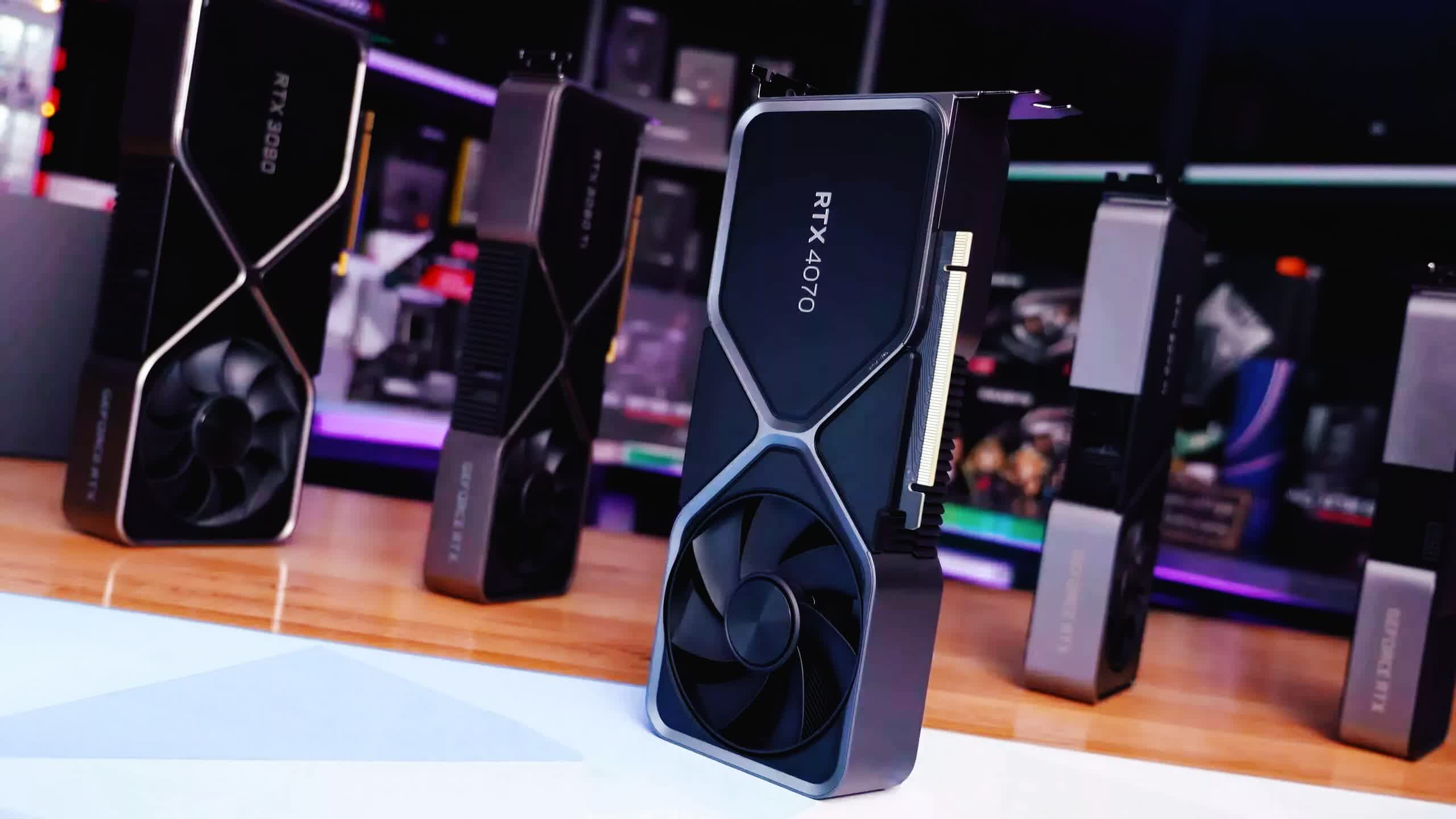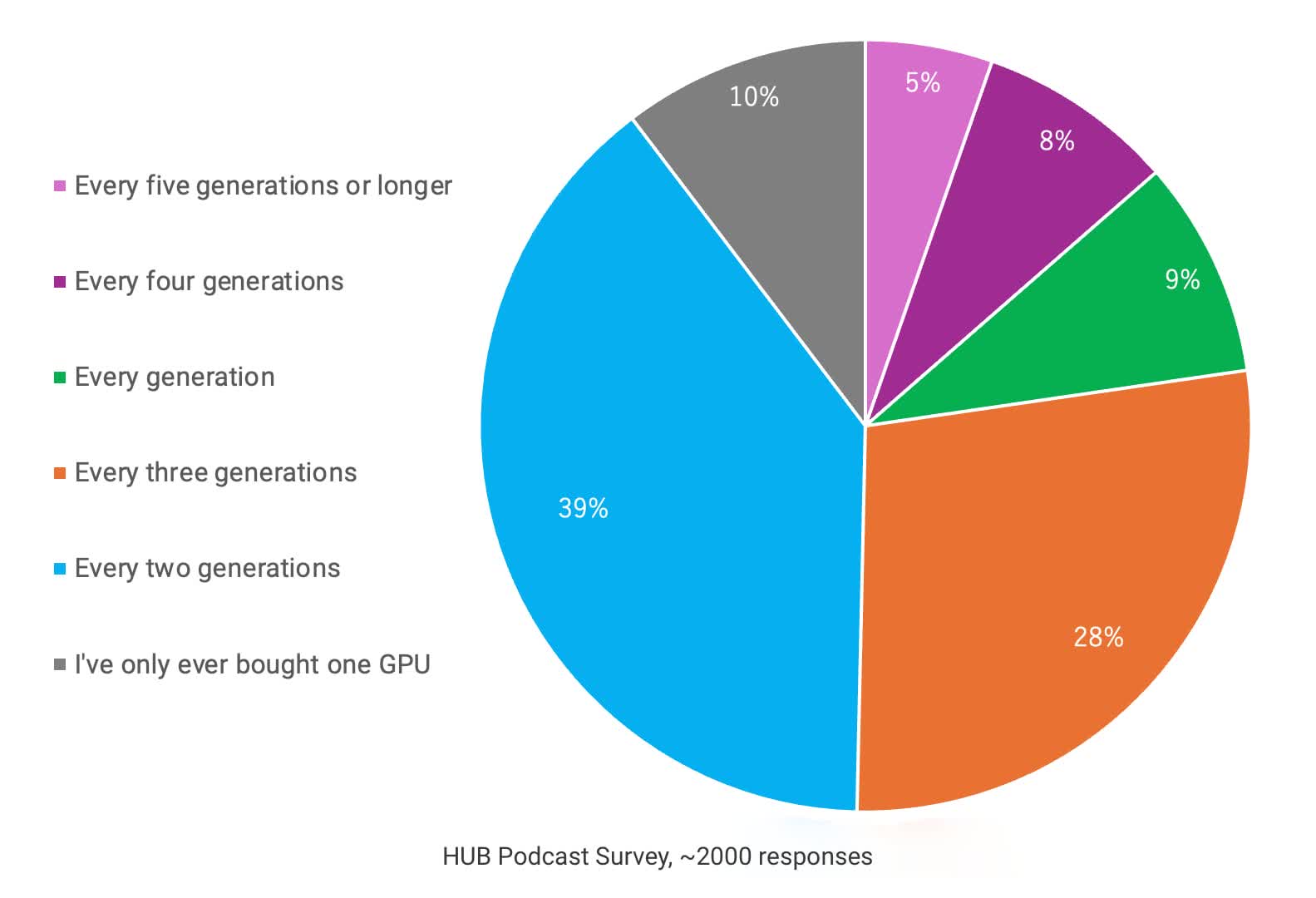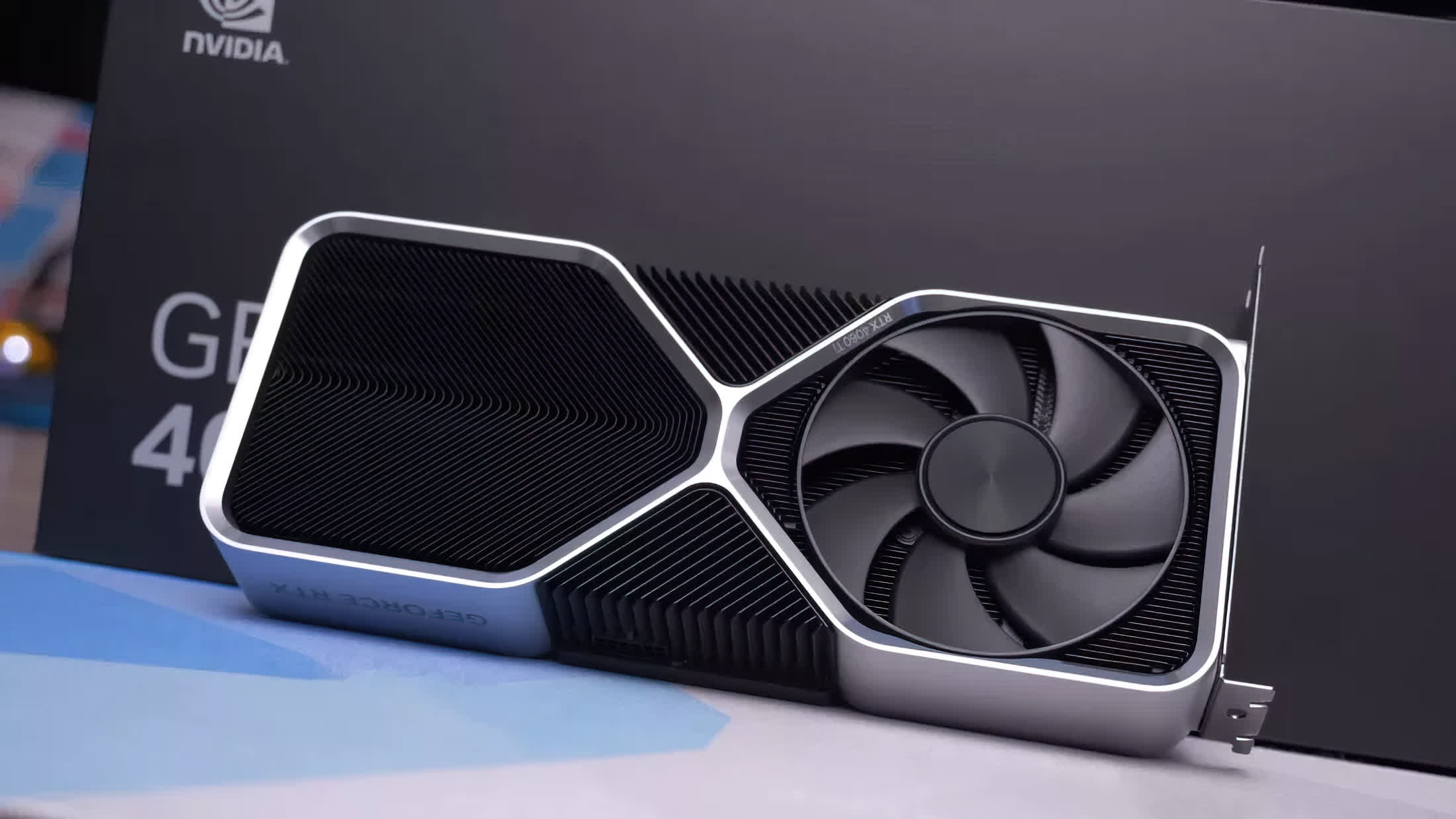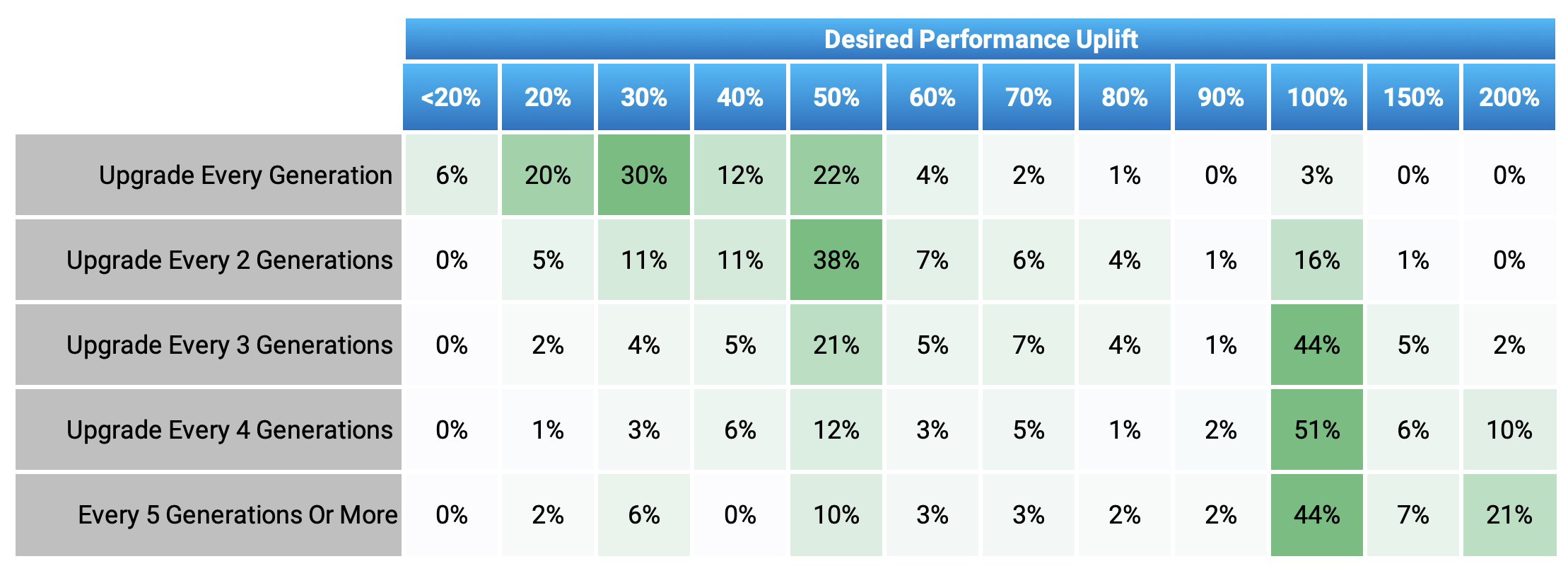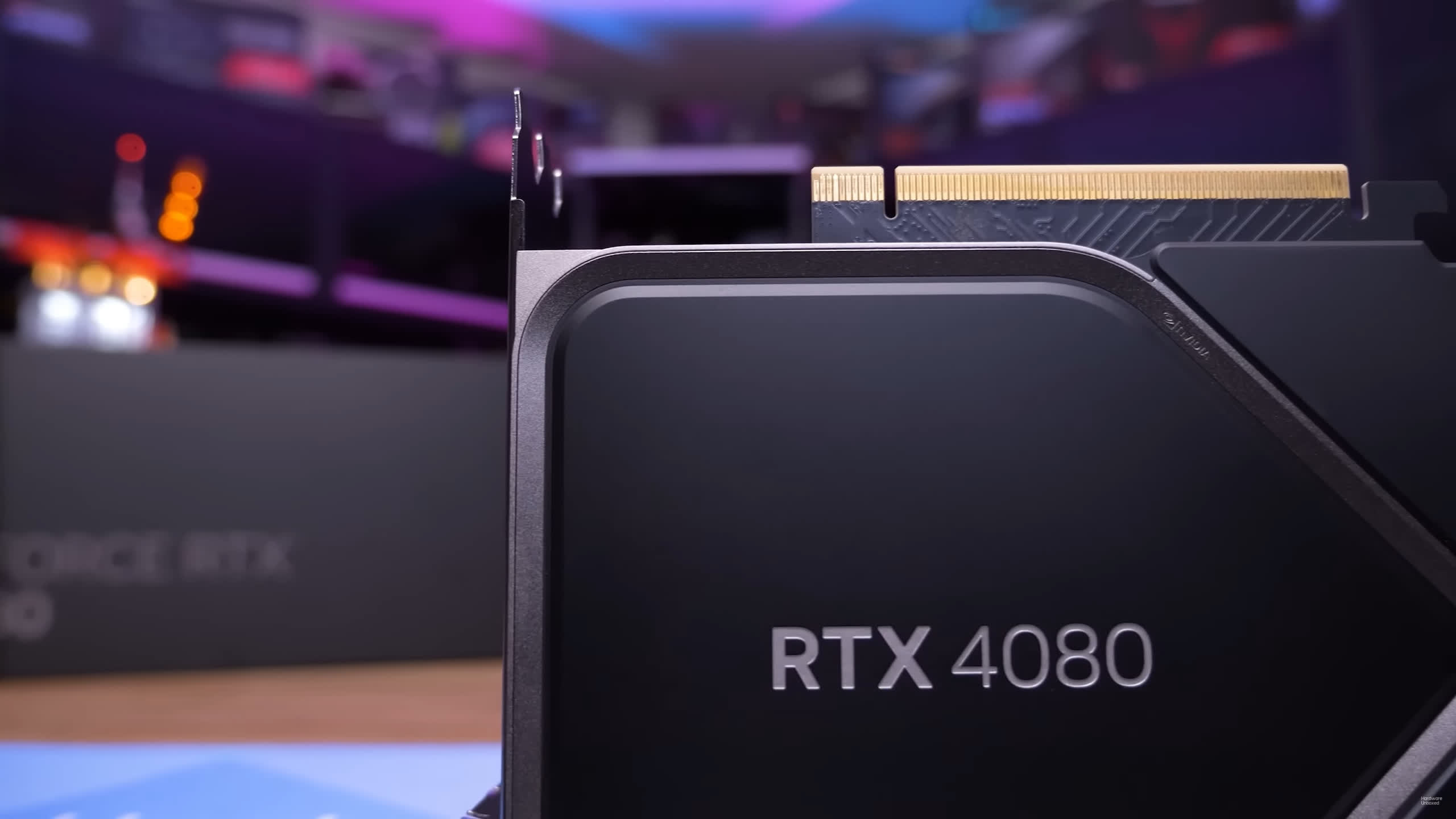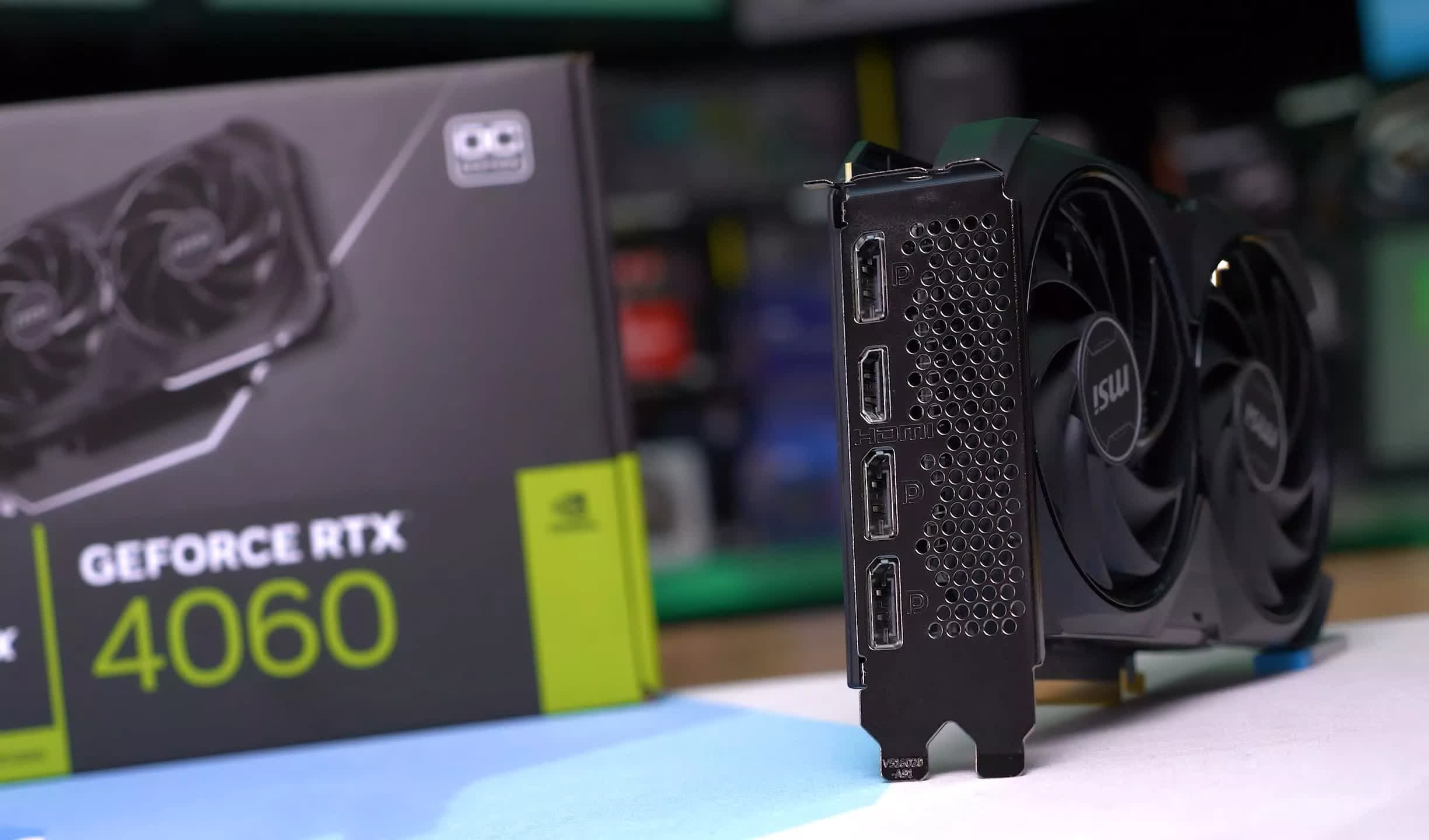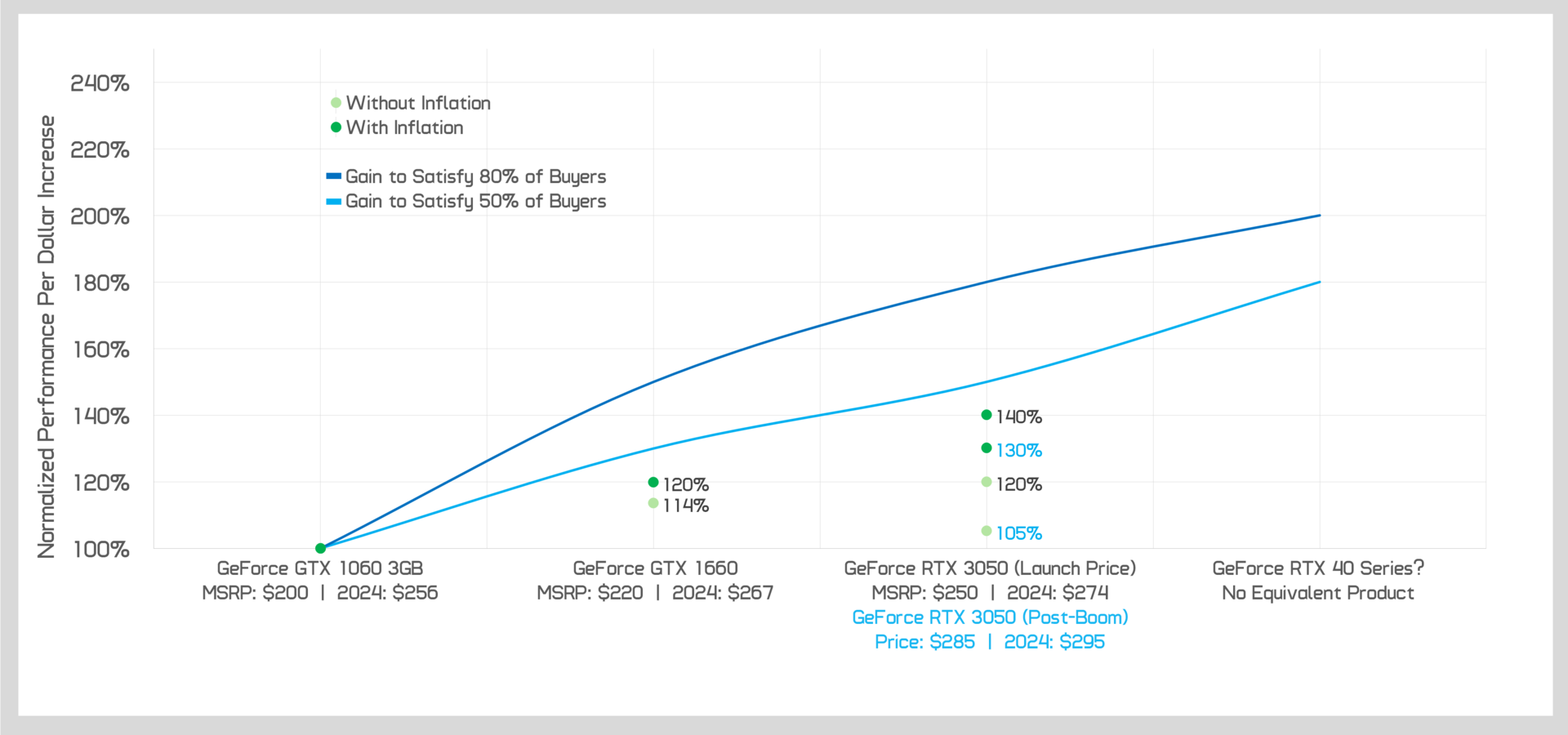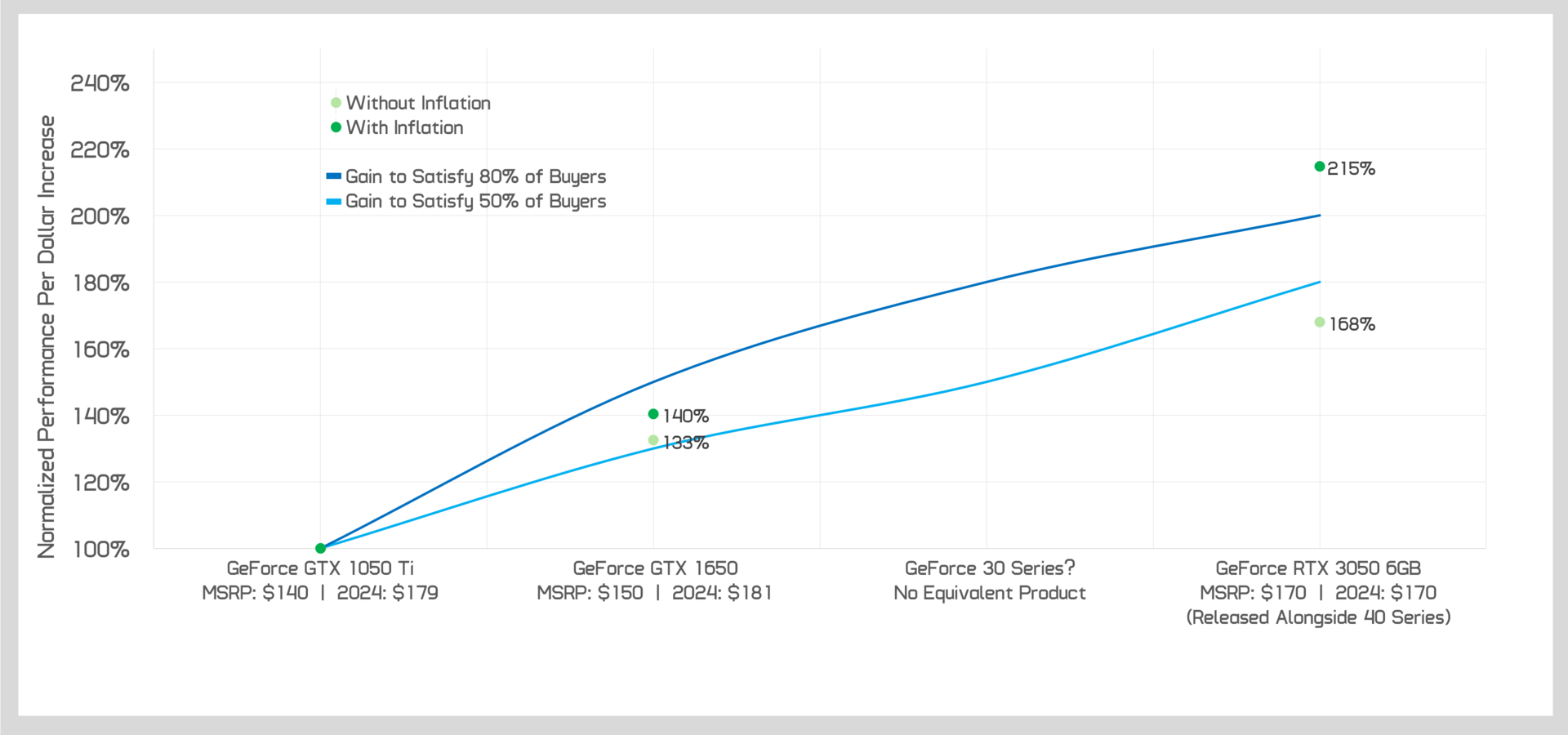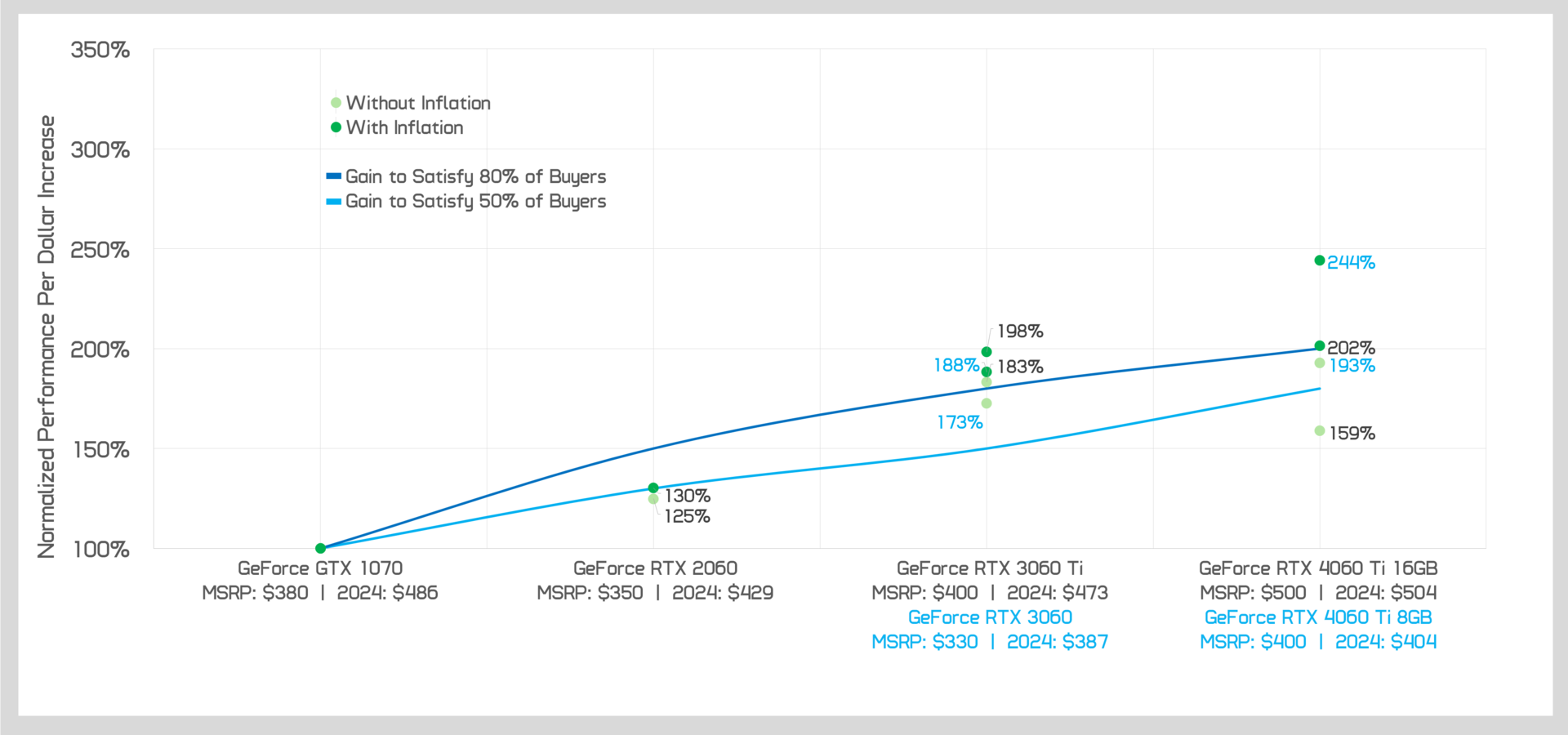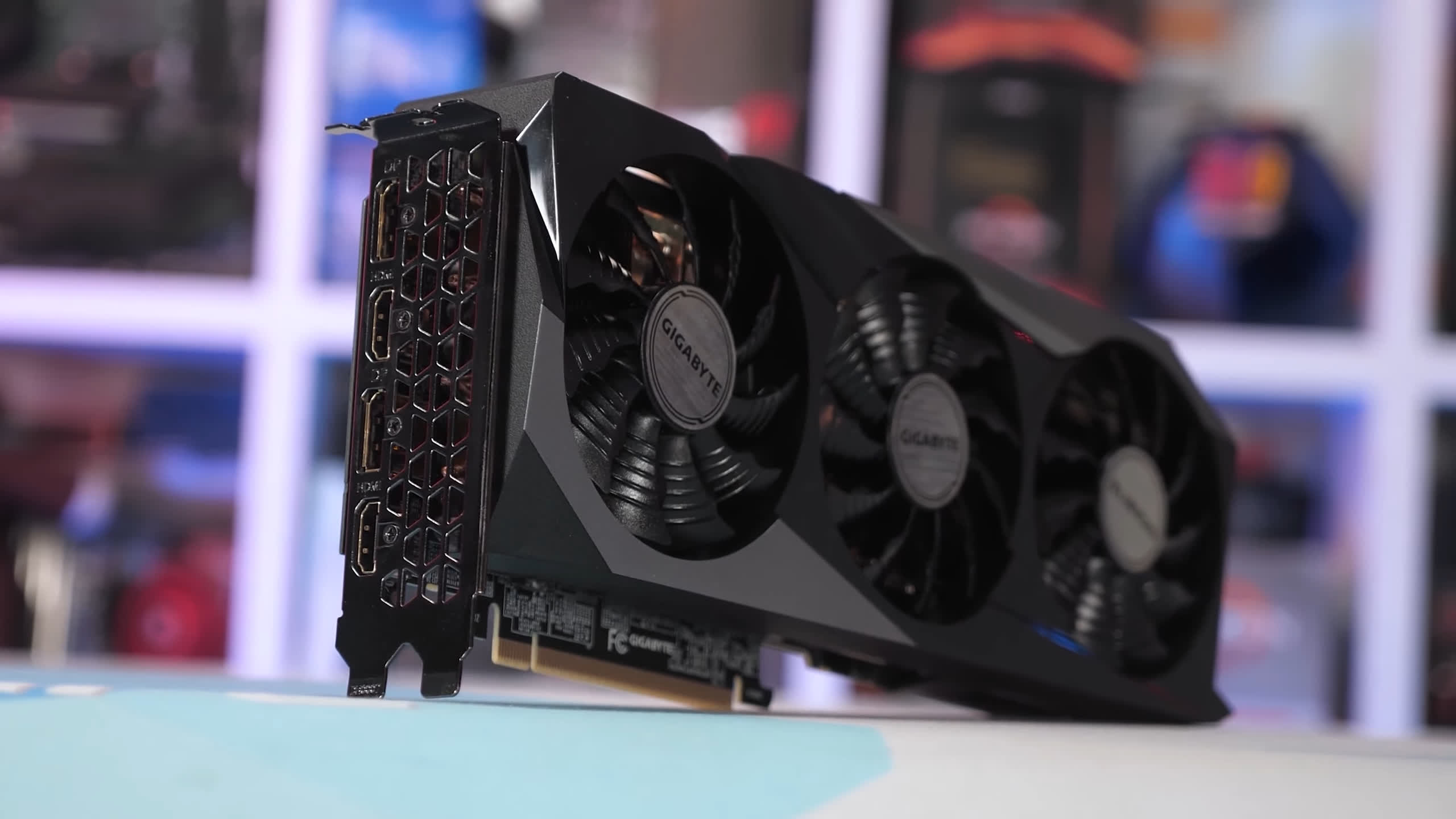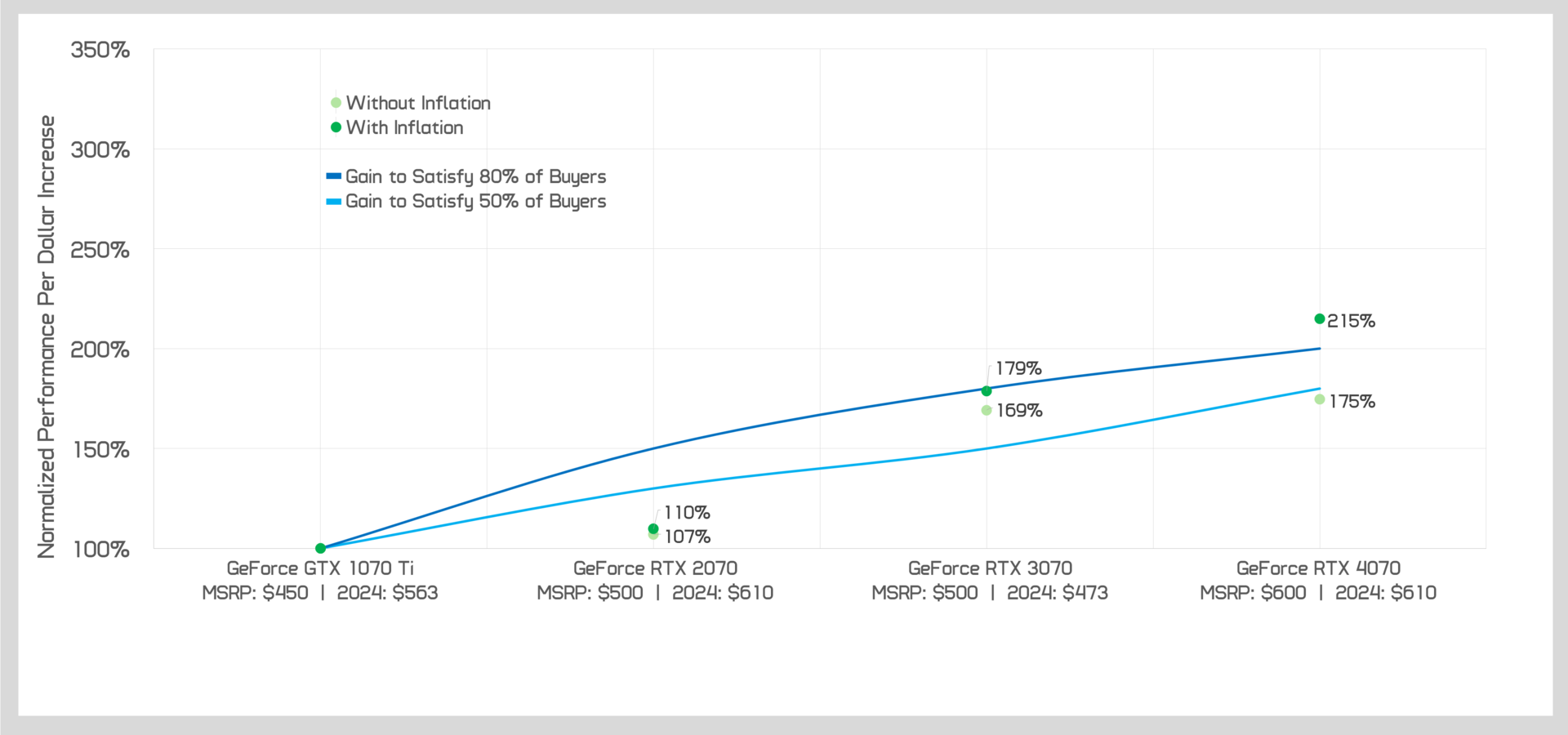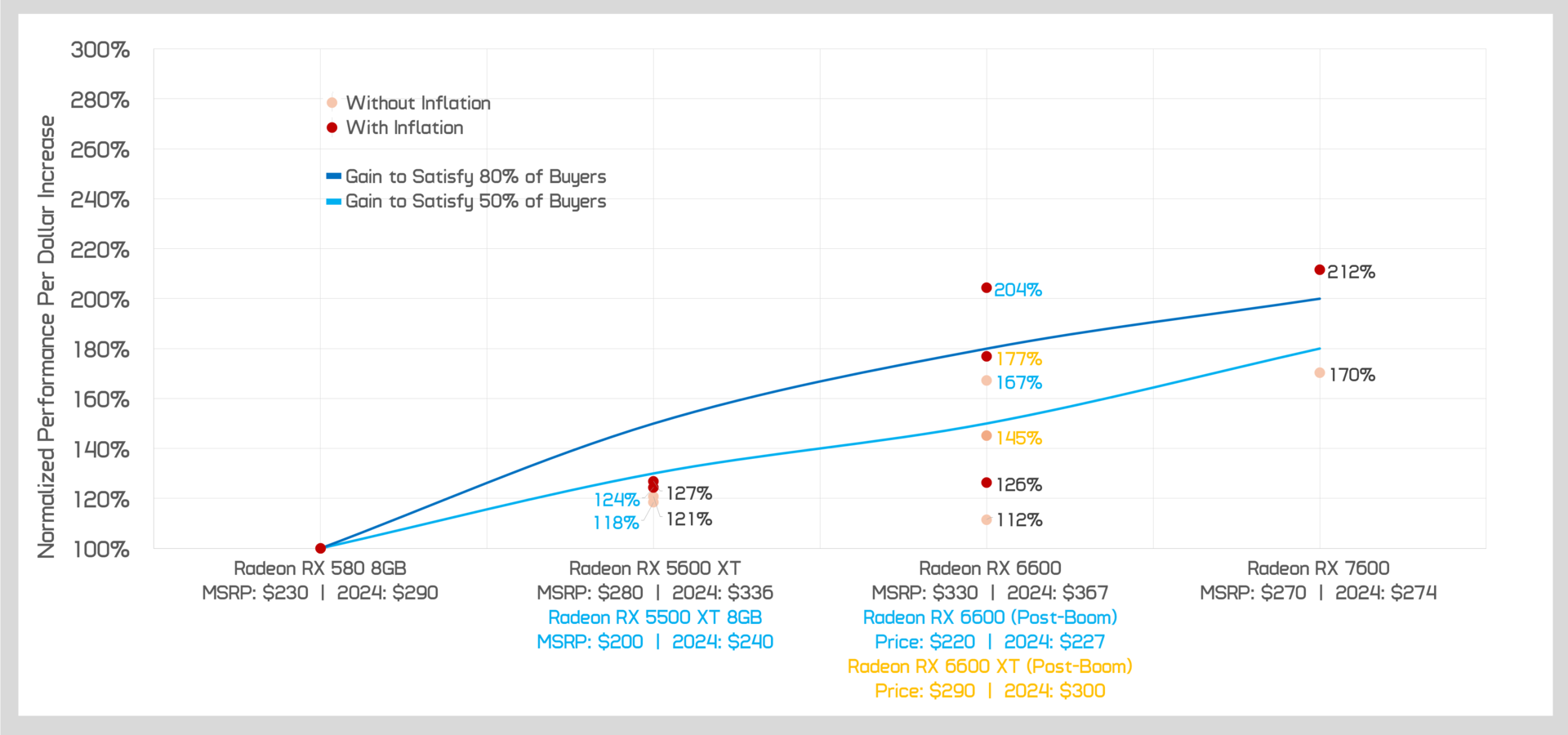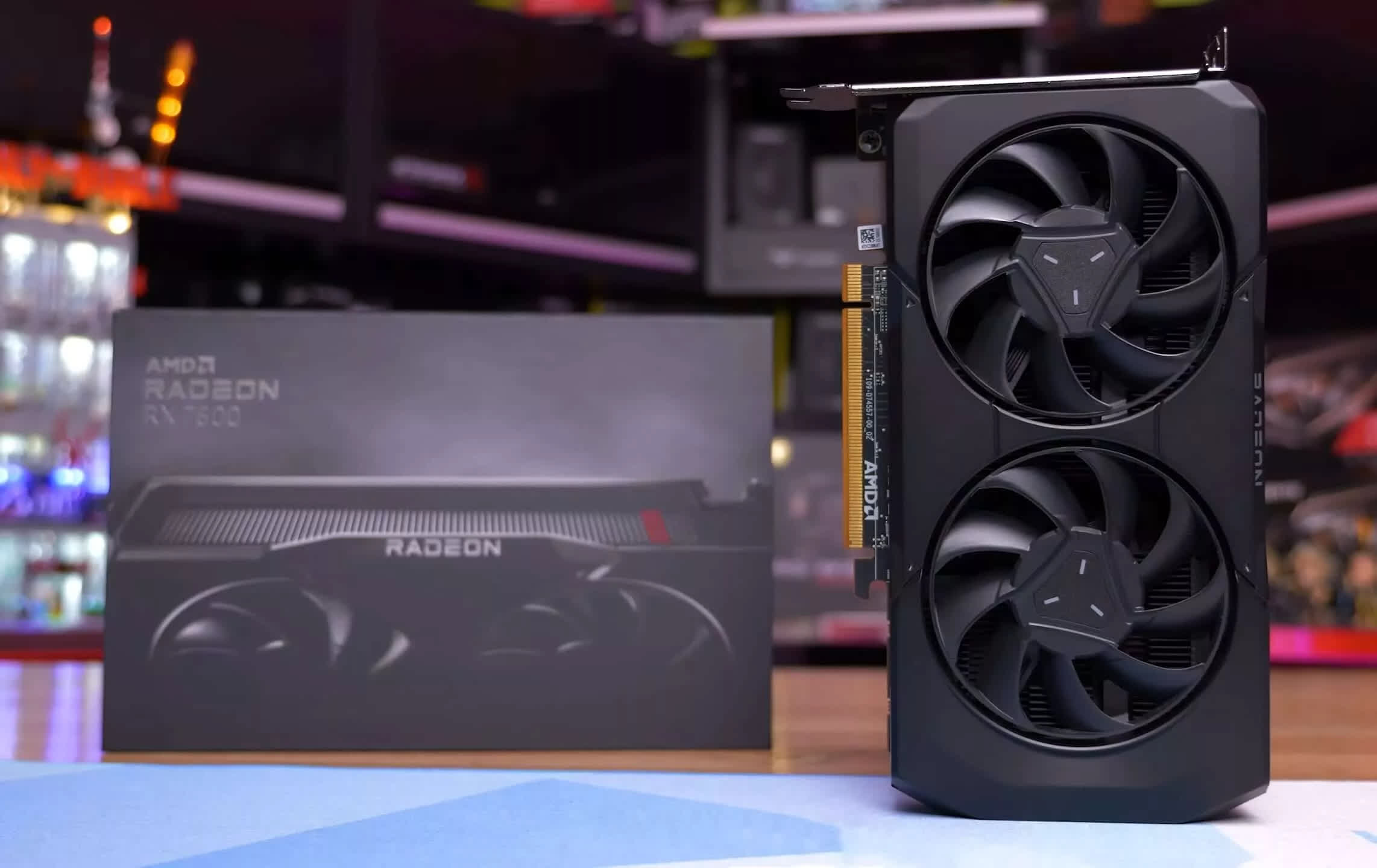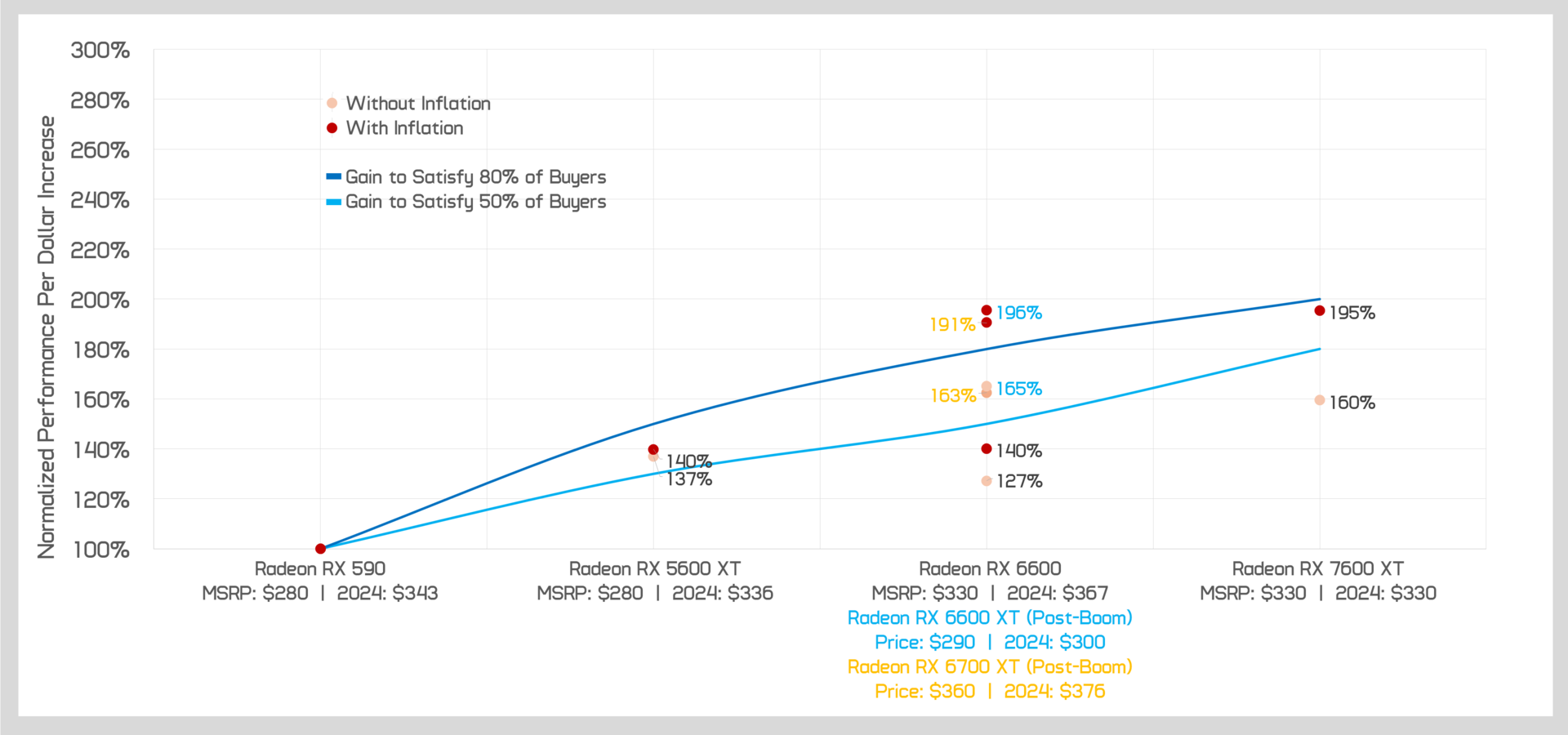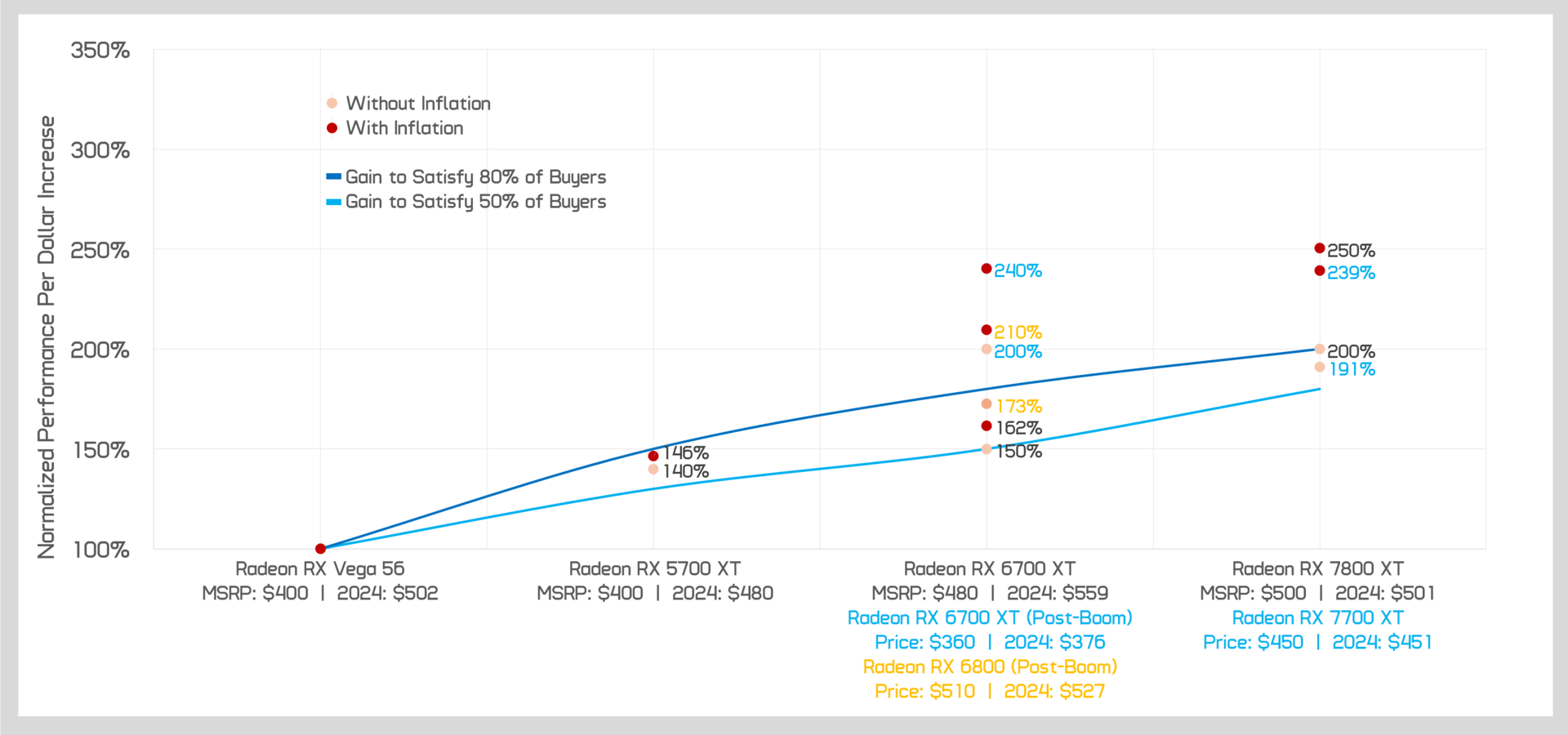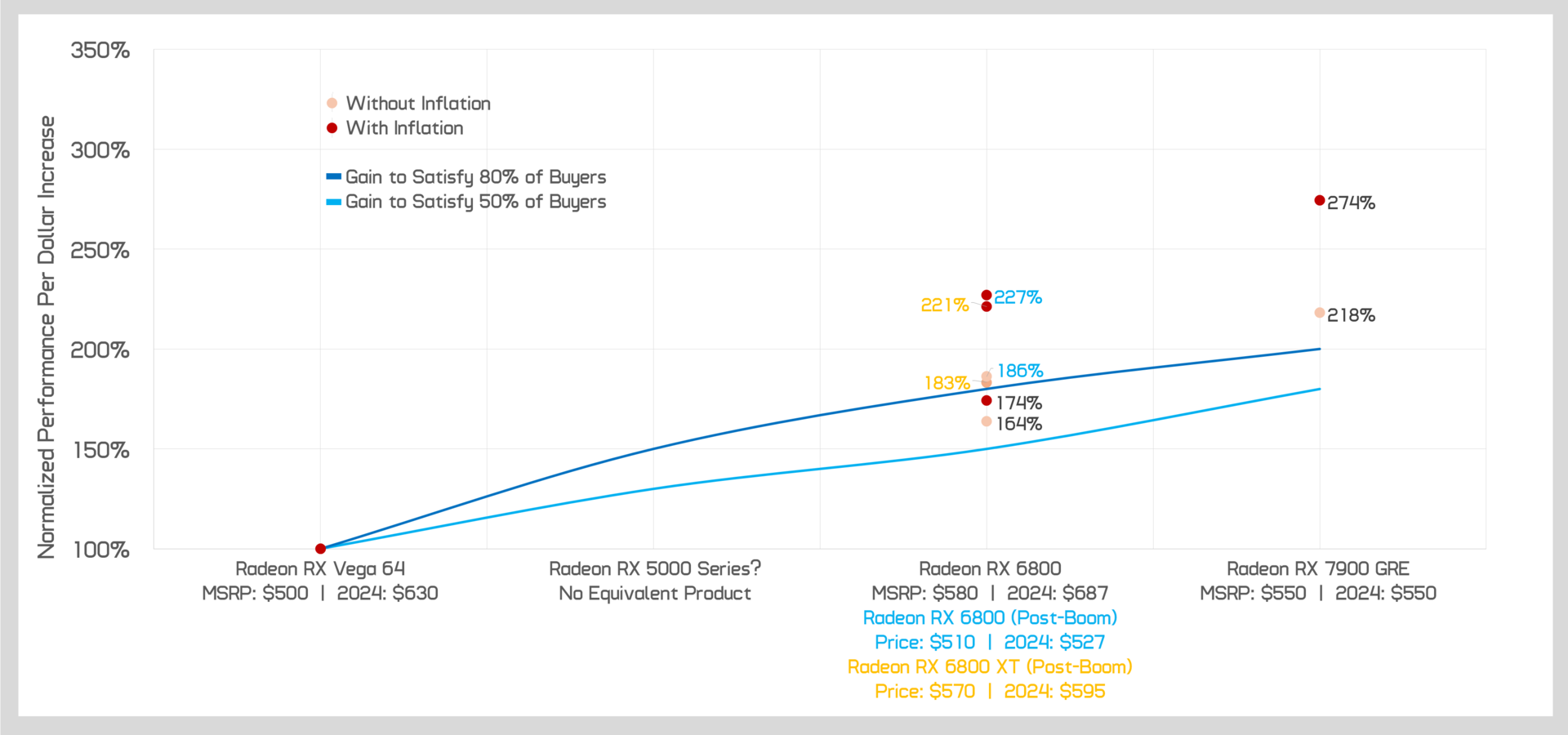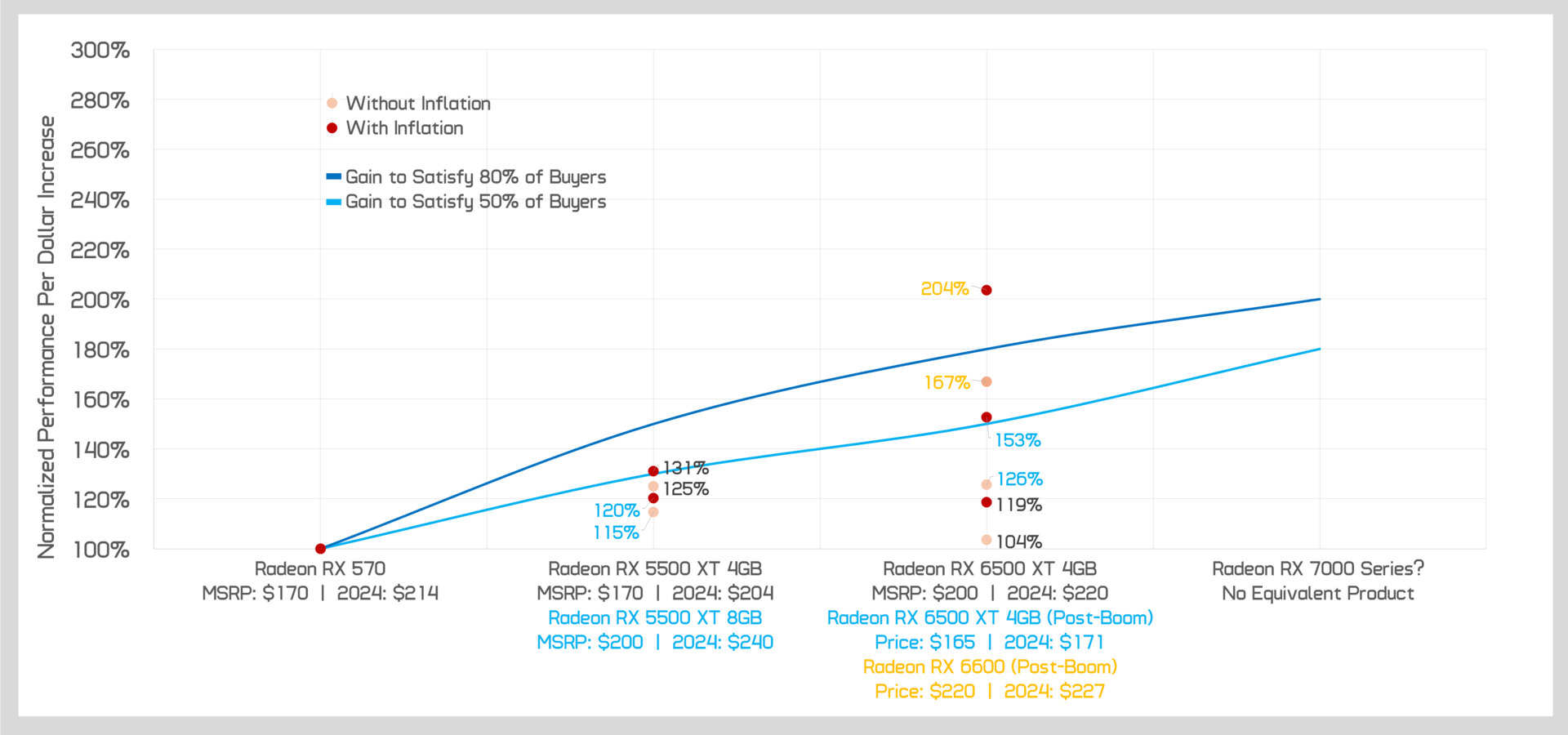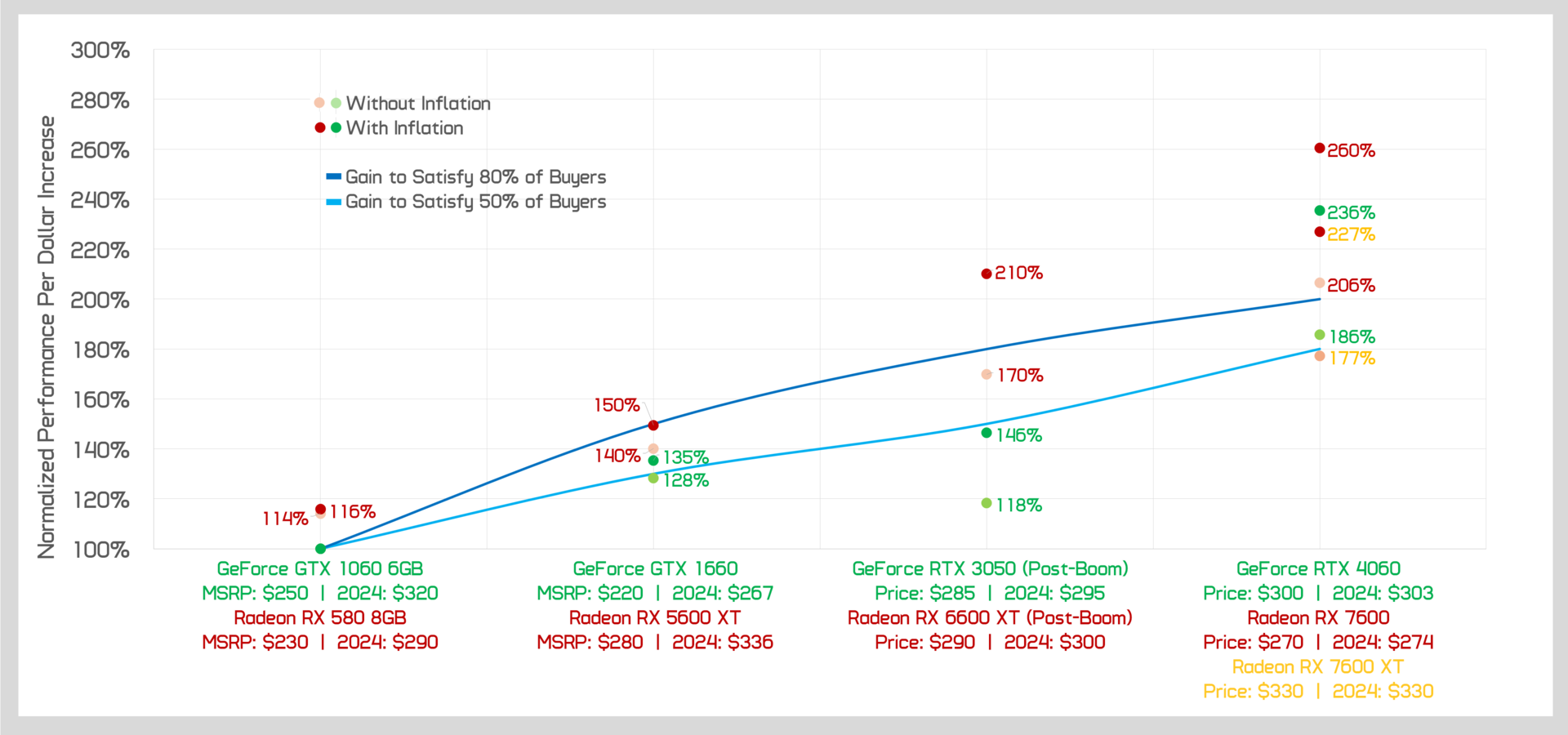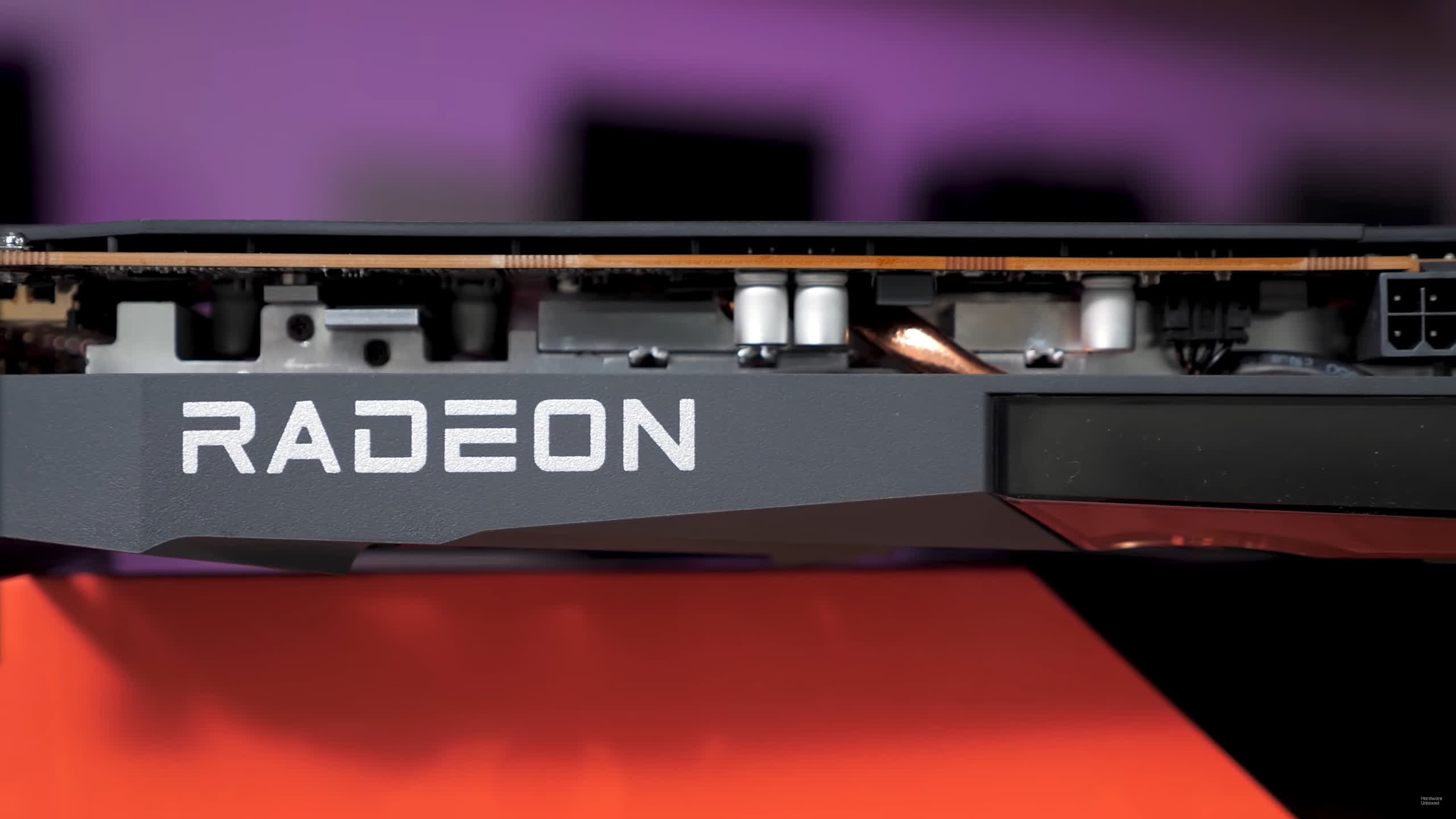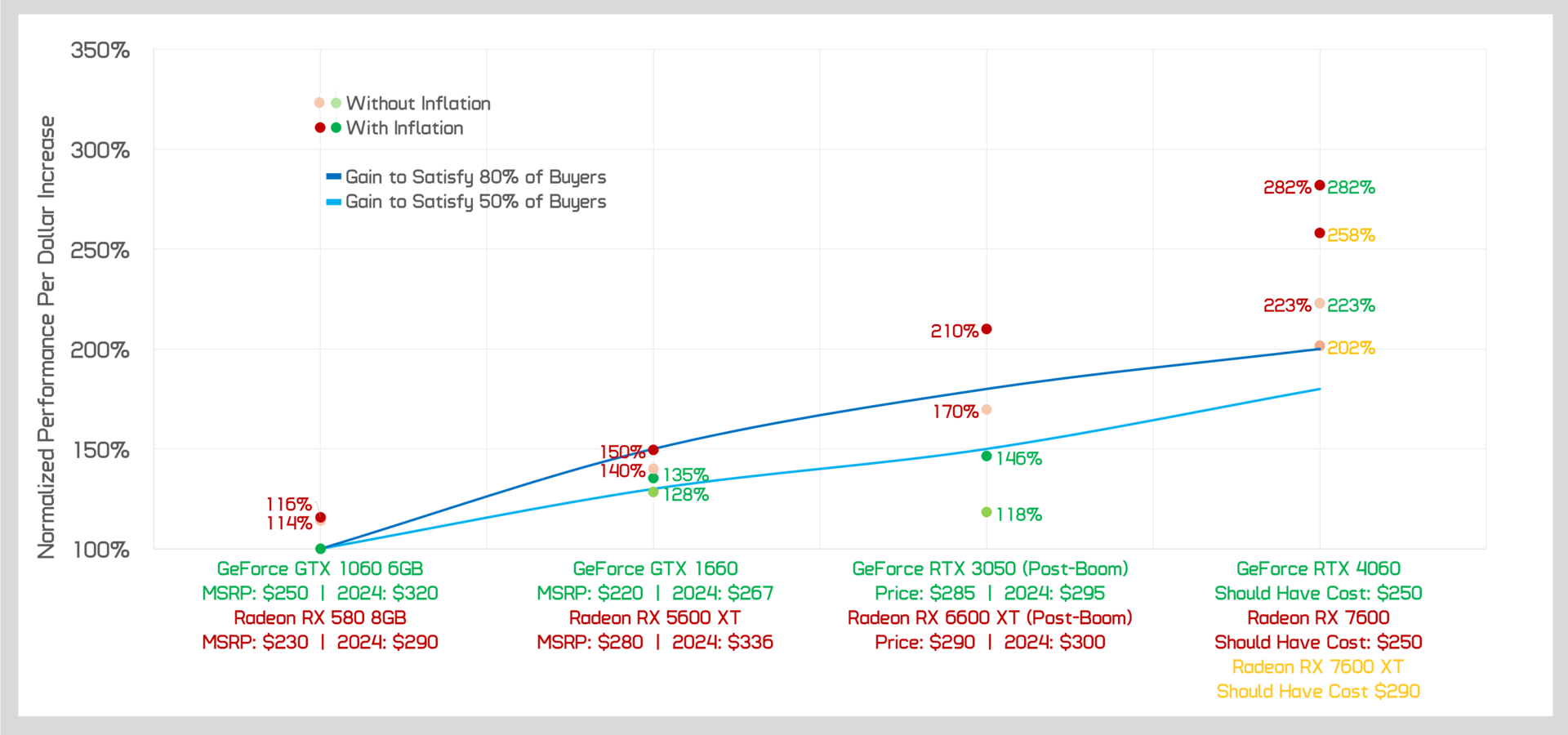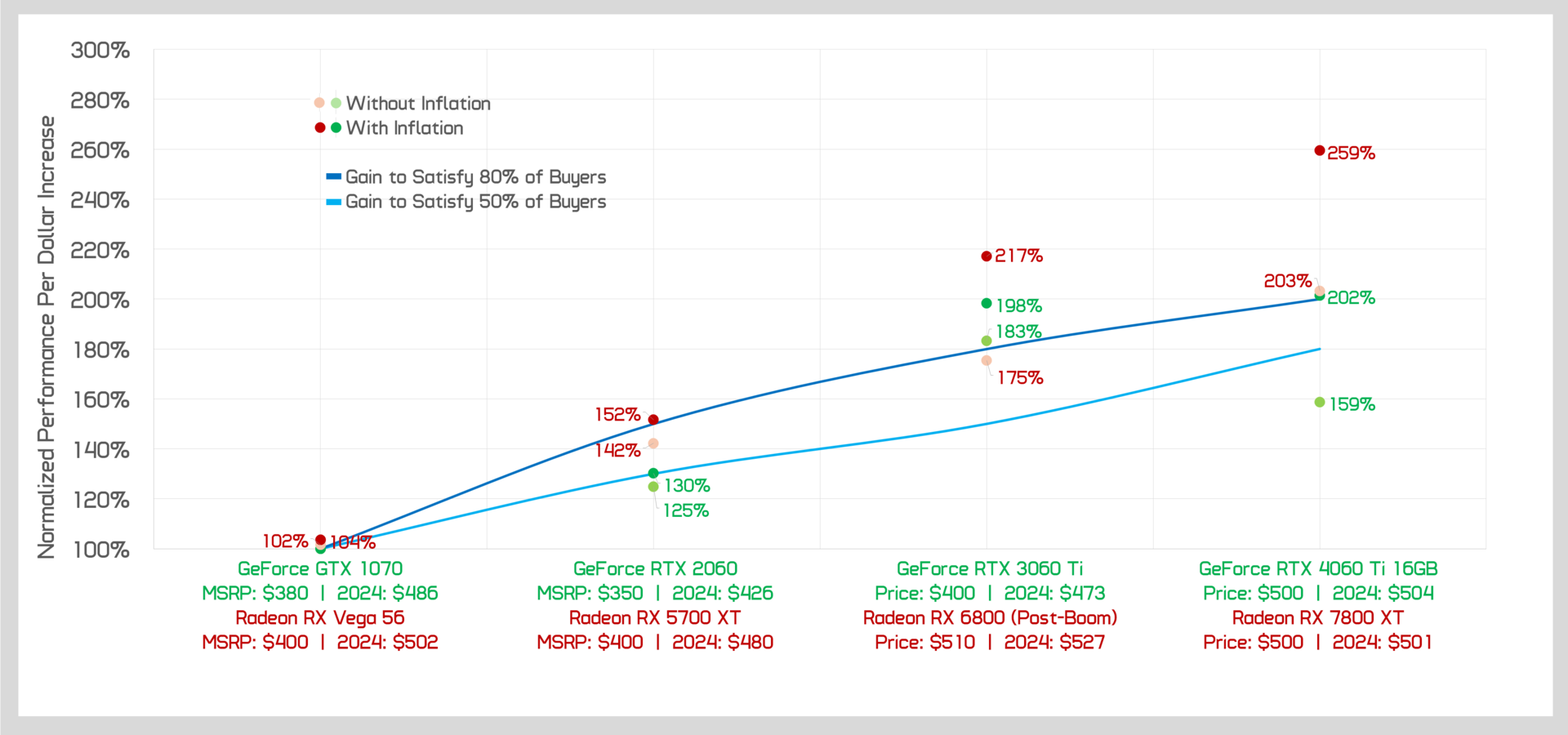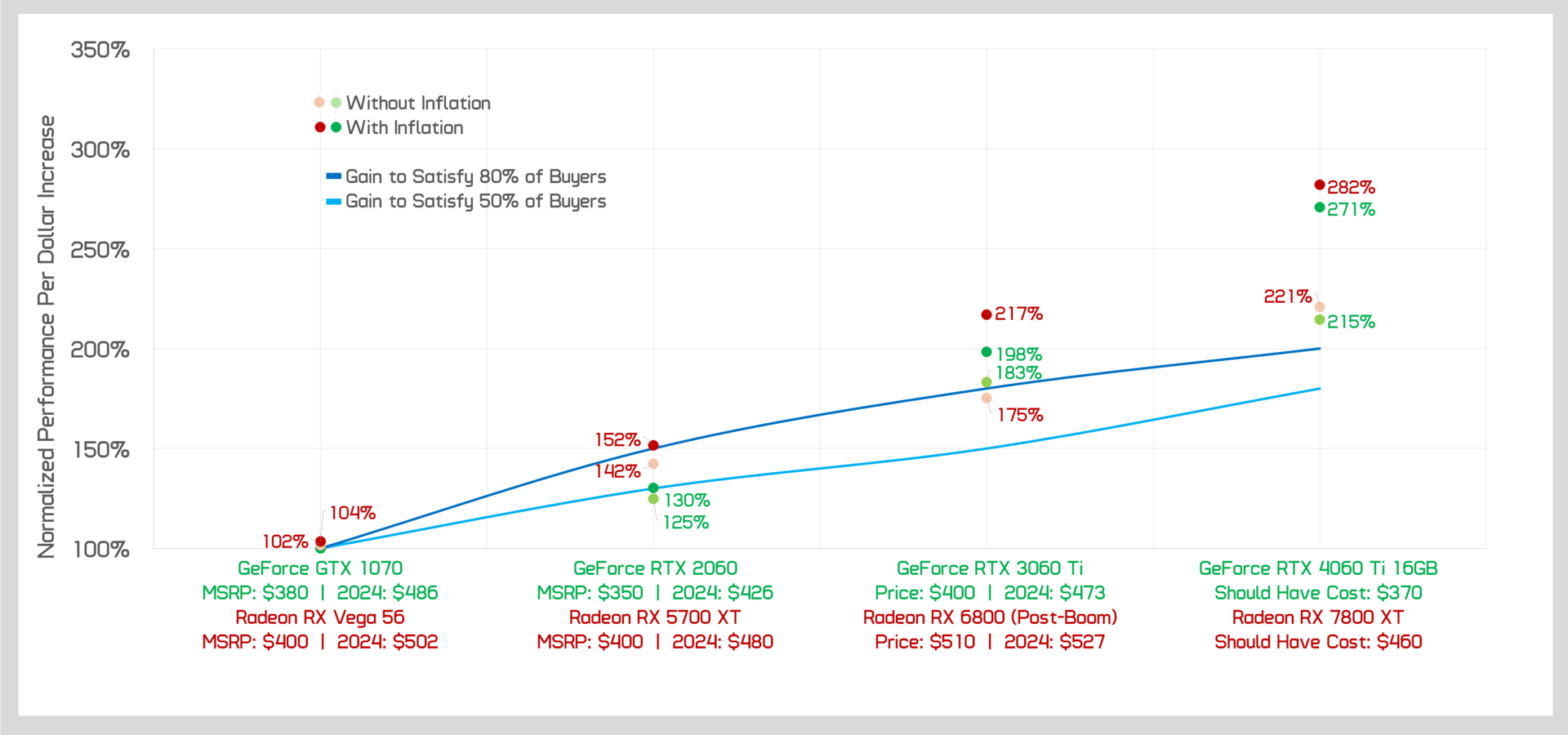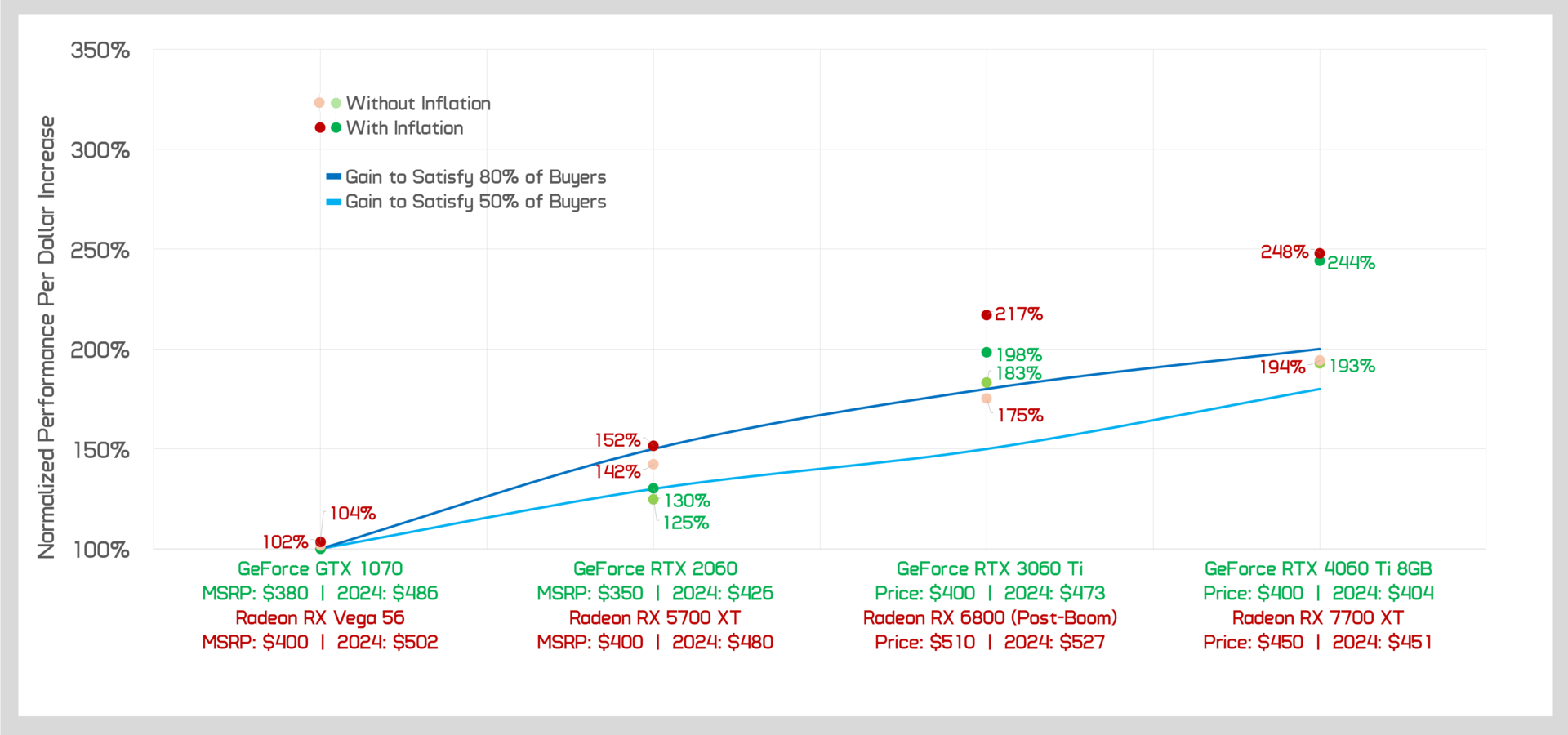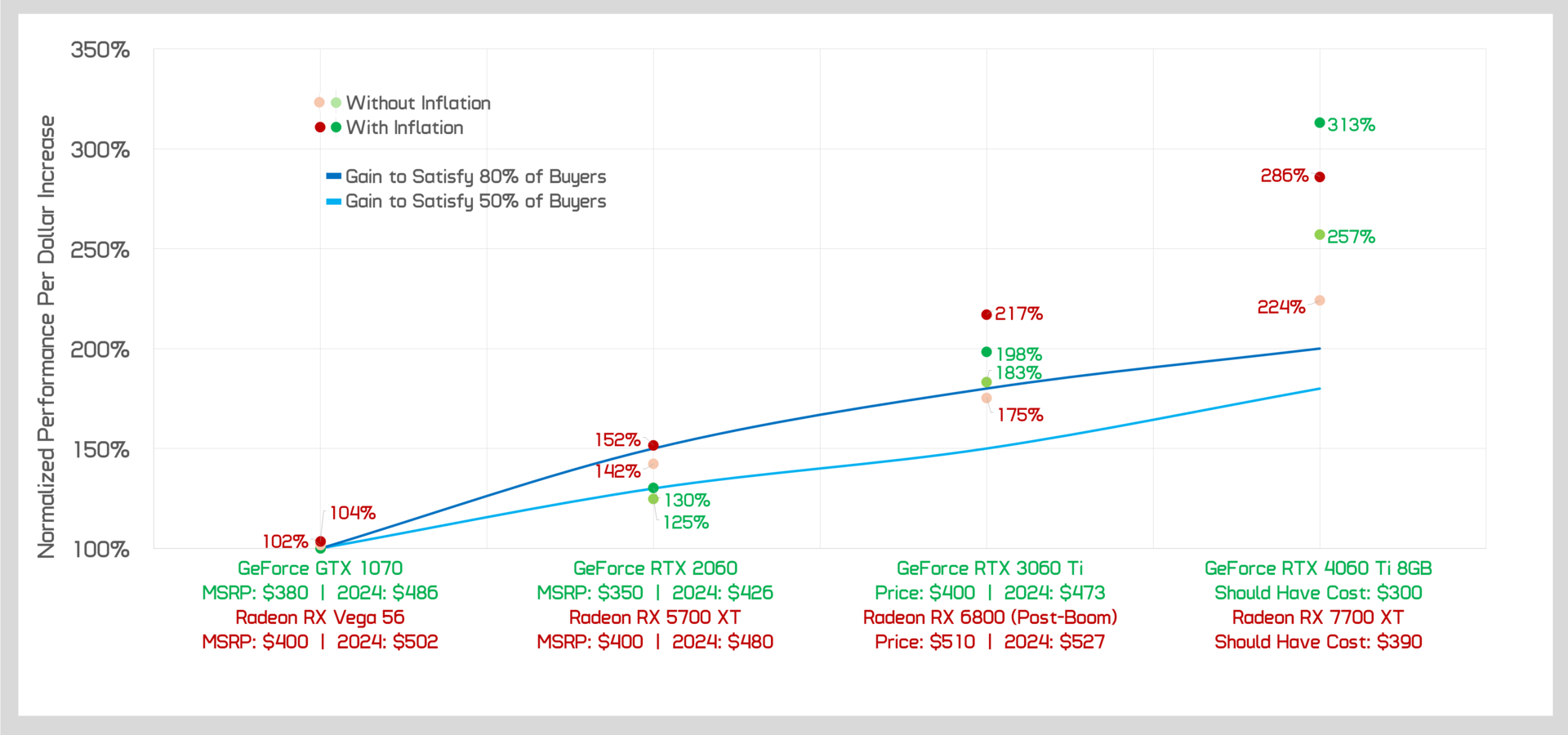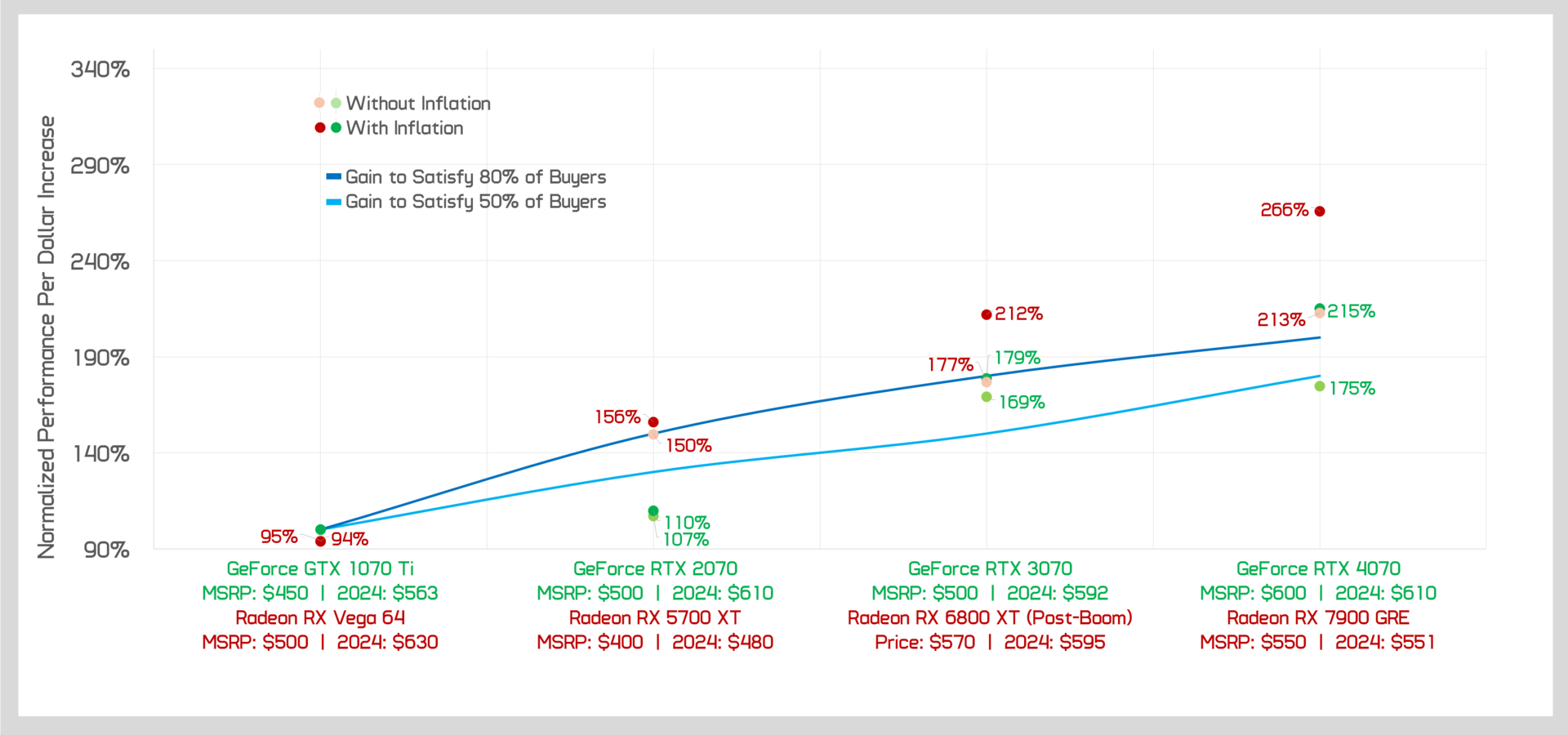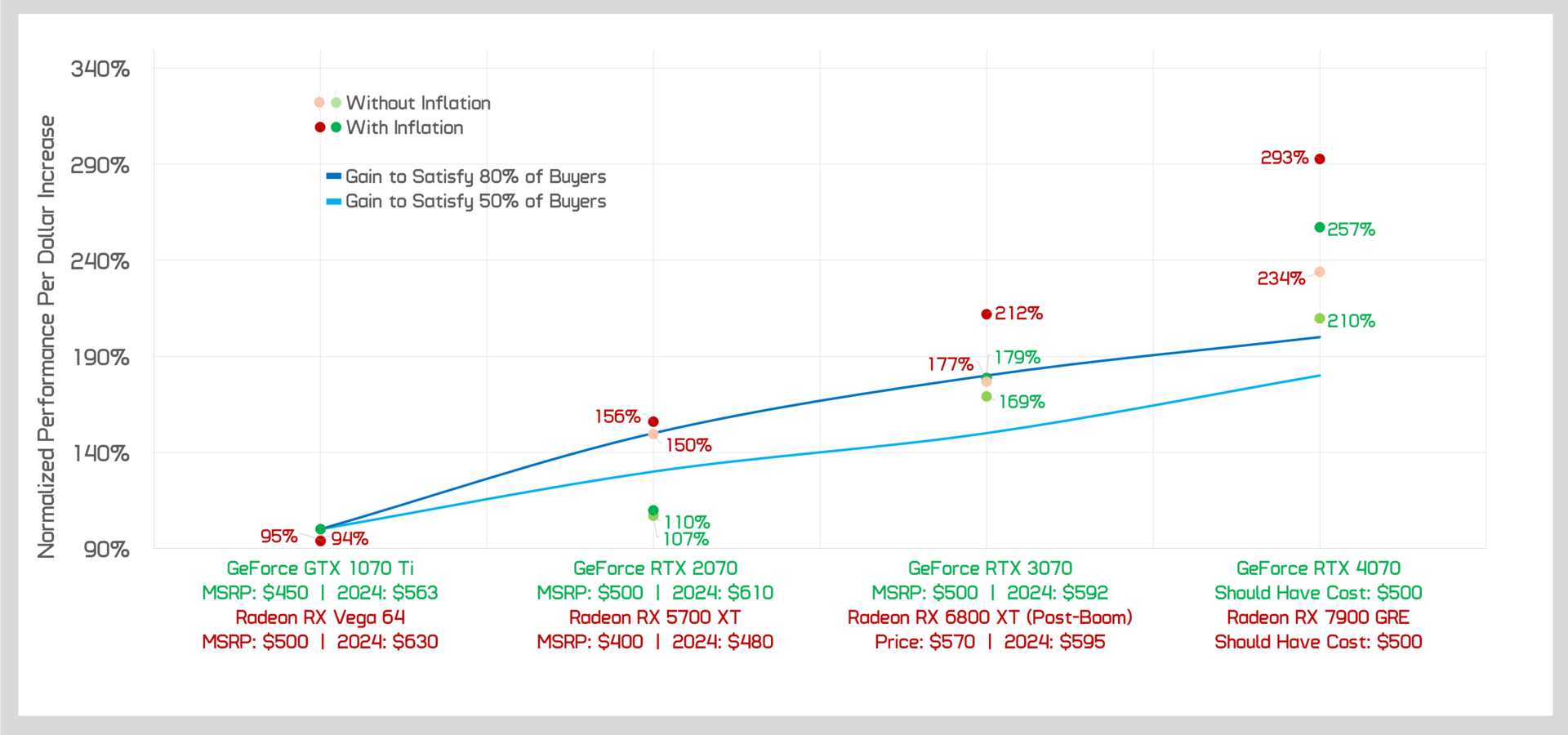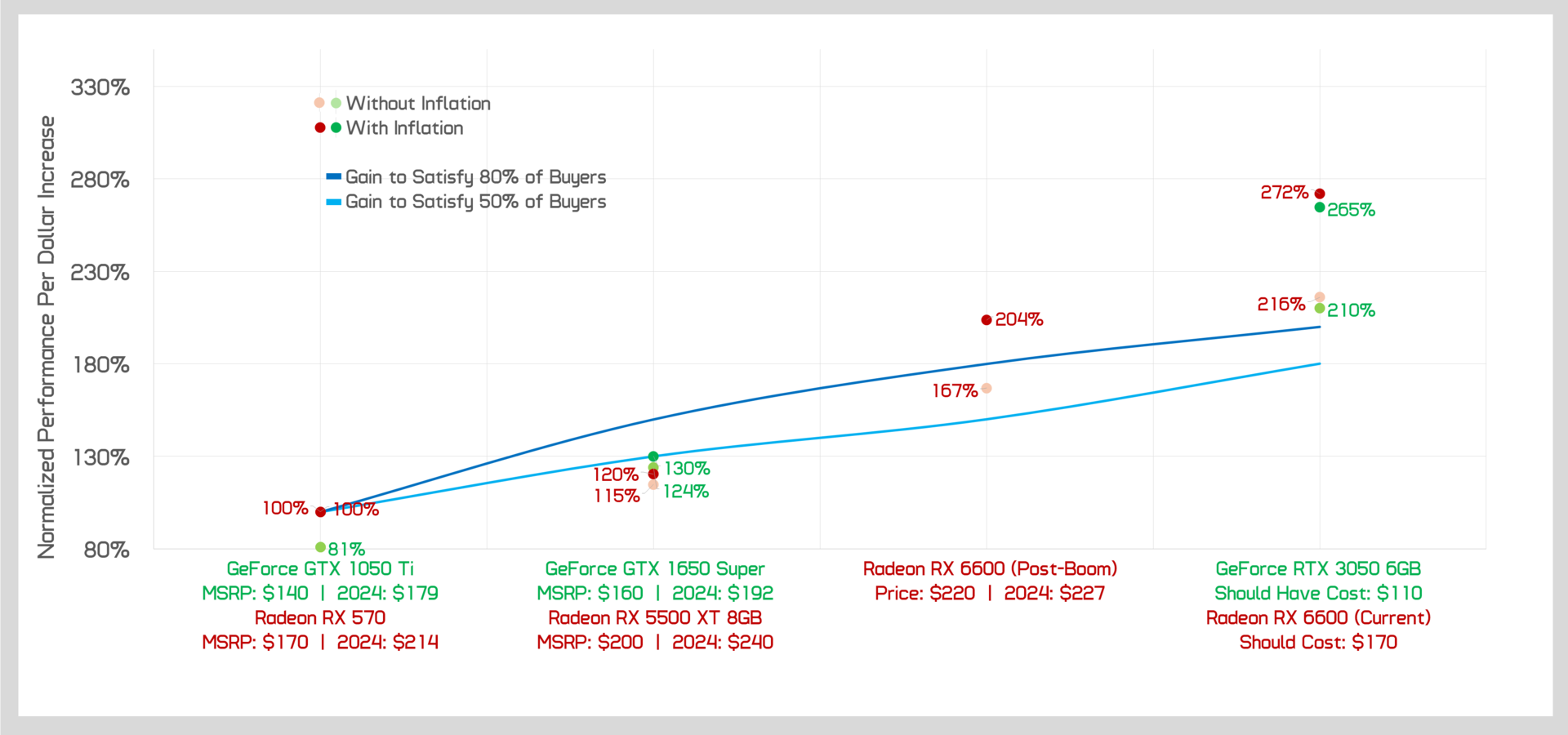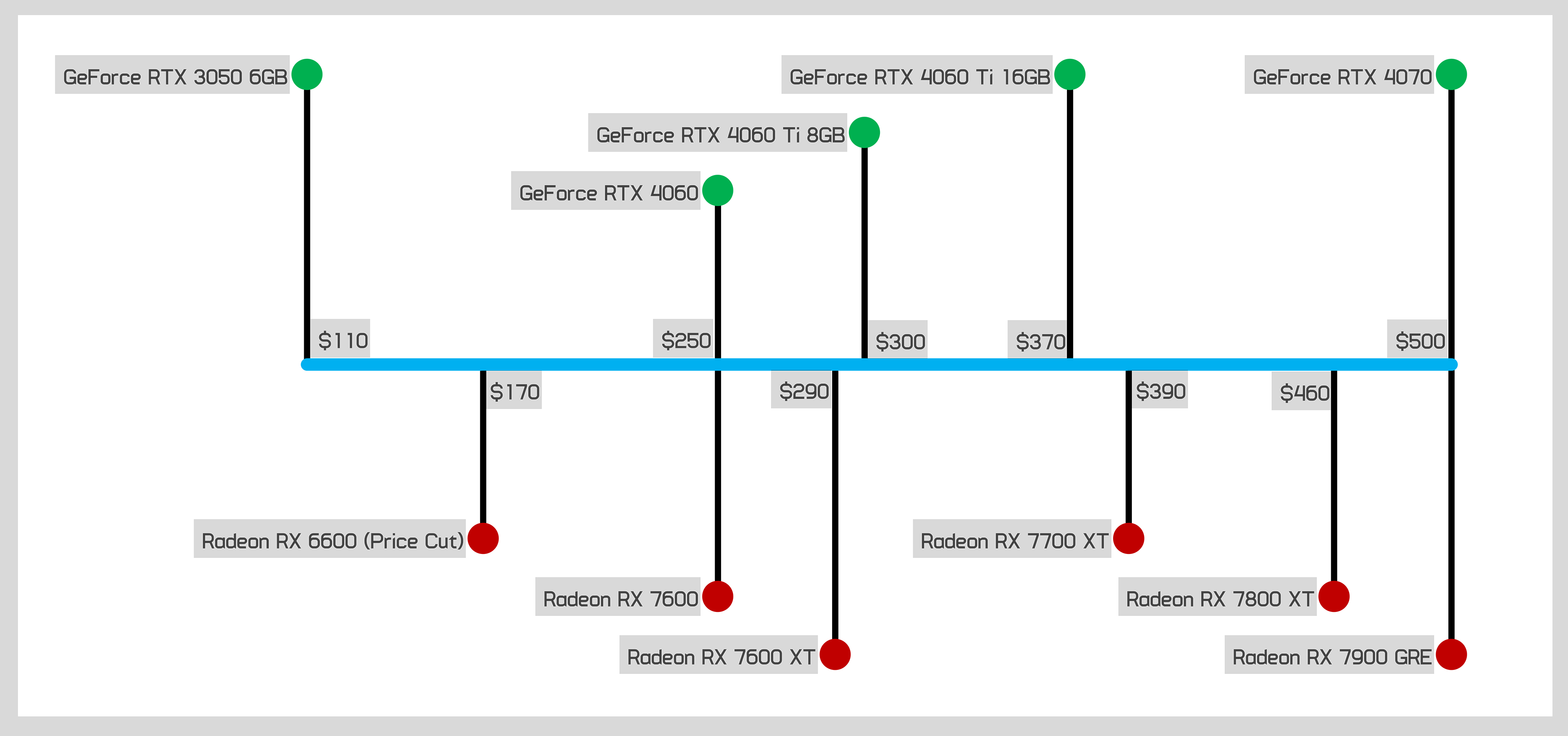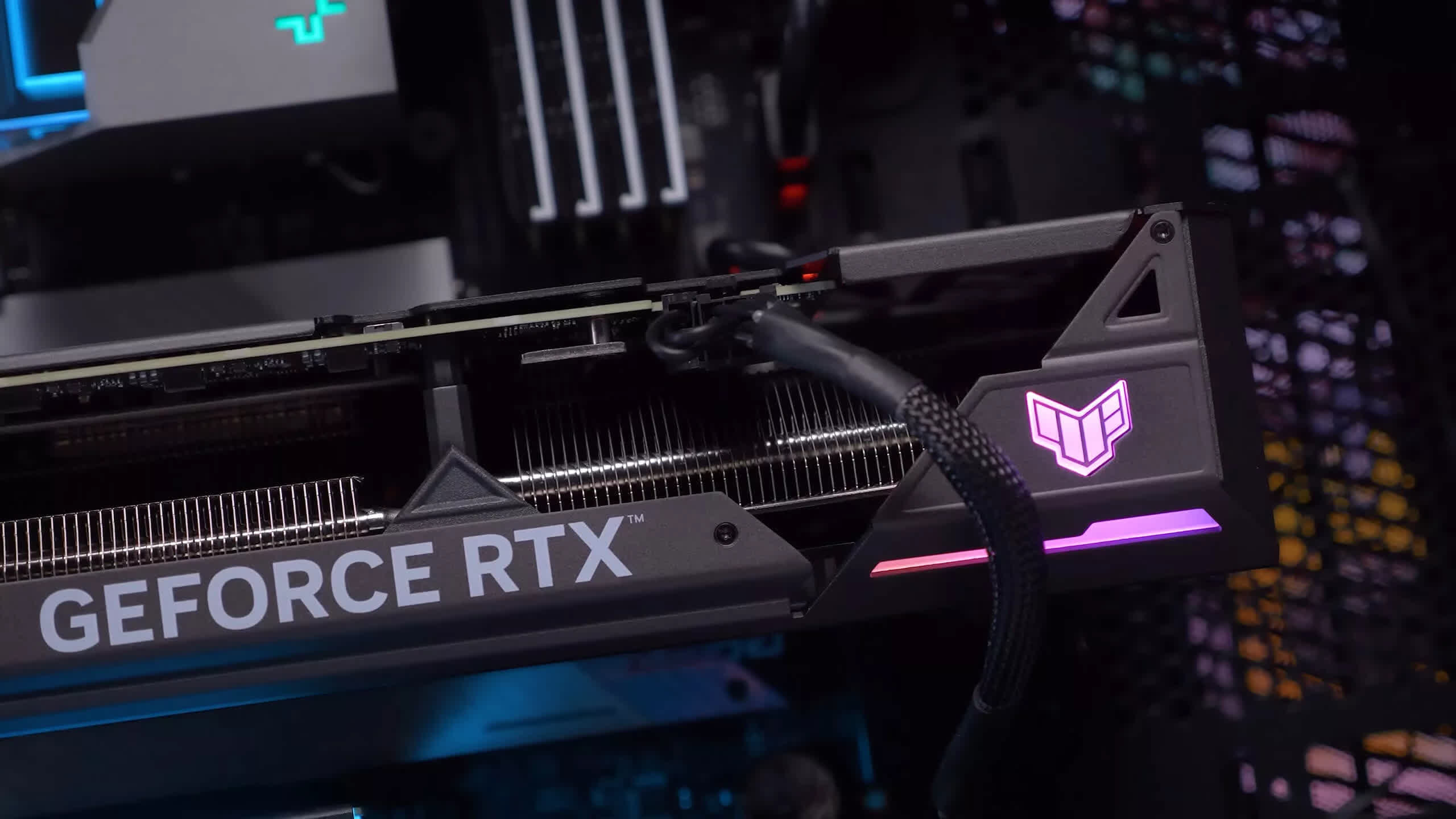We know that the current GPU generation has been a disappointment for many. High graphics card prices, stagnation in the mid to budget parts of the range, and a few puzzling releases with nonsensical MSRPs. Today, we're going to look back across the last four generations of graphics cards to illustrate exactly why this generation has underperformed – and by how much.
Additionally, we will "correct" the lineup to show what each GPU actually should have cost.
Granted, there are many different GPU buyers, and everyone upgrades their GPU at a different rate. Some people are satisfied upgrading every three generations, while others seek an upgrade every generation. We recently polled the audience of the HUB Podcast and found that ~40% of you prefer to upgrade every two generations, about 30% every three generations, 10% every generation, with the rest choosing other options.
Survey: Graphics Card Upgrade Frequency
With such a range of upgrade cadences, expectations for the performance of a new product will vary widely. Someone who upgrades every generation will be satisfied with a much smaller improvement over their current GPU compared to someone upgrading every three generations.
Ultimately, if a new GPU manages to satisfy the broadest range of PC gamers by delivering that sweet spot performance uplift for both frequent and less frequent upgraders, the generation will be deemed more successful.
We asked you, when buying a new GPU, how much performance you are after at the same price, filtering this by how often you upgrade your GPU. For those who upgrade every generation, the most common answer was desiring at least 30% more performance. For upgrades every two generations, the expectation rose to at least 50% more performance. And for those upgrading every three generations, the majority wanted their performance doubled.
This establishes the benchmark for what a new GPU should offer to buyers – at least within an audience of gamers, PC builders, and tech enthusiasts – which is fair to say, new GPU generations usually aim for. This means that an Nvidia RTX 40 series graphics card, for example, should be offering about 30% more performance than the RTX 30 series, 50% more than the 20 series, and double the performance of the 10 series – without any increase in price.
Upgrade Frequency vs Desired Performance Uplift
Exceed these expectations, and you have a standout product from an exceptional generation. Fail to meet these benchmarks, and the product is unlikely to see significant demand, with many likely to criticize it heavily on Reddit and in our reviews comments (which is exactly what we've seen this generation).
Knowing what our audience wants, we can now evaluate each GPU generation against these expectations. To do this, we created a normalized performance-per-dollar index based on our performance testing over the years.
Since people expect 50% more performance every two generations at the same price, we had to account for Nvidia and AMD altering the pricing structure over time, hence we focused on performance per dollar rather than raw performance. However, it's also important to factor in inflation. For instance, the GeForce GTX 1060 6GB was priced at $250 when it launched back in July of 2016. In 2024 dollars, $320 has the same purchasing power as $250 nearly 8 years ago, according to the Consumer Price Index.
Taking all these factors into account, we have compiled a series of graphs, but before diving into the details, let us explain the graph's components
- Every chart uses graphics cards from the 2016-2017 generation as the baseline.
- The lower blue line represents the performance uplift needed each generation to satisfy at least 50% of the survey respondents
- The upper blue line targets the satisfaction of at least 80% of the respondents. For instance, 55% of people who upgrade every generation selected an option between 0 and 30%, so an upgrade of at least 30% would satisfy those buyers; while 88% of upgraders in that category selected an option between 0 and 50%.
- Also included on these charts is the performance per dollar information with and without inflation considered, marked in two shades of green.
- Pricing information is also listed below the chart.
Nvidia GPU Value: $250-300
Graph: Improvement over time
In this first chart, we focus on Nvidia GPUs priced around $250 to $300. Transitioning from the GTX 1060 6GB, the GTX 1660 represented a reasonable performance per dollar increase. However, the RTX 3050 was somewhat underwhelming, only satisfying upgraders after factoring in inflation, and that only if the card was actually available at $250.
For most of its lifespan after the cryptocurrency boom ended in late 2022, the 3050 was priced more closely to $280 to $290, making it even less attractive compared to the 1060, as illustrated by how far below the blue lines some of those points are.
However, when considering the RTX 4060, it actually offers a significant performance per dollar increase over the 1060 6GB for those upgrading every three generations, as it is more than twice as fast.
With each generation comes new expectations for future generations, so we reset the blue line markers to match what would satisfy a GTX 1660 upgrader. Here, the RTX 4060 still performs reasonably, though only when inflation is considered. A similar observation can be made for individuals looking to upgrade from an RTX 3050 after a single generation.
Nvidia GPU Value: $200-250
Graph: Improvement over time
What's been particularly disappointing over the last decade is the lack of improvement in the $200 to $250 price range. Not only is there no single RTX 40 series product in that range, but each generation since the GTX 1060 3GB has fallen short of expectations. The GTX 1660 offered only a 20% performance per dollar increase with inflation considered, and the RTX 3050 was particularly underwhelming. At such a mainstream price point, it's disheartening to see the lack of progress over time.
Nvidia GPU Value: Below $200
Graph: Improvement over time
When looking below $200, Nvidia has continued their trend of offering lackluster products in this price range. However, surprisingly, they've managed to maintain a consistent level of quality, offering roughly the same level of performance with each new release. For GTX 1050 Ti owners, both the GTX 1650 and RTX 3050 6GB represent a significant upgrade. However, for GTX 1650 owners, the RTX 3050 6GB appears to be a less appealing upgrade, though it is not awful.
Nvidia GPU Value: $350-500
Graph: Improvement over time
In the $350 to $500 range, the situation becomes much more interesting. For owners of the GTX 1070, the RTX 2060 was on the verge of being acceptable but, without considering inflation, slightly underwhelming. Then came the RTX 3060 Ti at a similar price point, which was a definitive win for most people, assuming one could find it at $400. With a performance per dollar improvement of over 80%, this product would have incentivized many upgrades, which is likely why people were eager to acquire one (crypto boom aside).
Looking at today's products, the RTX 4060 Ti in both capacities is not a terrible upgrade from the GTX 1070, especially when taking inflation into account. So, why was this generation's product received poorly?
Well, its success is not just based on a comparison to an 8-year-old GPU. While it also represents a reasonable upgrade from the RTX 2060, the real issue arises when resetting expectations based on what was delivered with the RTX 3060 Ti. We can now see that the 40 series has been an underwhelming release compared to the previous generation, failing to achieve a significant performance uplift for those purchasing every generation.
This also impacts people with older cards. If one had a GTX 1070, a great upgrade would have been the 3060 Ti. However, if one chose not to purchase that Ampere GPU, hoping for an even better product in the 40 series, banking on gaining another 30-ish percent on top of the significant improvements seen in the 30 series, the wait might not have been worth it. Waiting 2 and a half years for an underwhelming new product could lead to regret for not purchasing the excellent last-gen model, or it might not be convincing enough to prompt a change from waiting. Essentially, if the 3060 Ti wasn't sufficient, why settle for the 4060 Ti?
Nvidia GPU Value: $500-600
Graph: Improvement over time
Nvidia faced similar challenges in the $500 range. This situation highlights how the RTX 2070 fell short of delivering a noteworthy generational gain. However, in a stark contrast, the RTX 3070 was a success, offering a significant improvement for Pascal owners, assuming one could purchase it at the suggested retail price. Then comes the RTX 4070, and opinions are likely to vary widely depending on whether one factors in inflation.
As we reset expectations for each generation, a similar pattern emerges. For those who purchased an RTX 2070, the 3070 presented as a fantastic upgrade, exceeding the gain needed to satisfy 80% of buyers. The 4070 also isn't terrible as an upgrade from the 2070, but relative to the 3070, if one were expecting a typical performance uplift, then it certainly did not deliver the required performance per dollar increase, as can be observed here.
AMD GPU Value: $200-300
Graph: Improvement over time
Moving now to AMD GPUs, let's focus first on their mainstream models around $250. For people who purchased the Radeon RX 580 8GB back in 2017, the journey has been a mixed bag. The RX 5600 XT was somewhat underwhelming, and the performance of the RX 6000 generation depends heavily on the price point considered.
Products like the RX 6600 and 6600 XT were launched well into the cryptocurrency boom and had MSRPs set to account for that. After the boom ended in the later stages of 2022, prices rapidly fell to a more "typical" level for that class of product, which is reflected in the post-boom numbers presented here.
It's possible those prices would have been the MSRP in a normal market, though it's hard to say. Both scenarios have been included to illustrate the effects either way.
Essentially, the Radeon 6000 series would have been a significant failure at the original MSRPs, but with adjusted pricing, it turned out to be a huge success, with both the 6600 and 6600 XT offering a decent upgrade over the RX 580. The RX 7600 also doesn't appear too bad as an upgrade choice, at least in this instance.
However, when recalibrating expectations based on the RX 6600 XT, the RX 7600 once again falls short. Similar to the situation with the 4060 Ti and other Nvidia GPUs, for those who skipped the previous generation expecting better performance a few years later, that hasn't been the case.
AMD GPU Value: $300-350
Graph: Improvement over time
At around $300, we examine upgrades from the Radeon RX 590 through to the 7600 XT. It's a continuation of the previously observed trend: for those upgrading from either an RX 5600 XT or an RX 6600 XT, the improvement offered by the 7600 XT is extremely underwhelming, with the only notable advantage being the doubling of VRAM capacity.
Mid-priced offerings are where AMD has typically offered the best value, and this trend persists across generations.
AMD GPU Value: $350-500
Graph: Improvement over time
Mid-priced offerings are where AMD has typically offered the best value, and this trend persists across generations. Coming from a Vega 56, the Radeon 5700 XT, 6700 XT, 6800, and 7800 XT have all been great upgrade choices; even the 6700 XT at its MSRP wasn't too disappointing.
When resetting expectations for the Radeon 5700 XT, AMD has continued to offer reasonable improvements, especially for those who acquired an RX 6700 XT post-boom. This trend continues with the 7800 XT, though only when inflation is considered. However, when expectations are based on the RX 6800, the 7800 XT appears underwhelming.
AMD GPU Value: $500-600
Graph: Improvement over time
Then, we have the products around the $600 range. The Vega 64 was an underwhelming release back in 2017, so it's no surprise to see the RX 6800 and RX 7900 XT offering significant improvements. However, if we reset expectations to the 6800 series post-boom, the 7900 GRE isn't really making the cut as far as a generational uplift is concerned.
AMD GPU Value: $200
Graph: Improvement over time
For lower-tier products around $200, AMD hasn't released as many disappointments as Nvidia and has been relatively consistent in providing a reasonable performance uplift with each generation. Compared to the RX 570, the Radeon RX 6600 at its post-boom price of $220 is quite an attractive GPU. However, the RX 6500 XT – a closer match when not considering inflation – was disappointing in terms of value. And currently, there is no 7000 series product in this price range, with AMD effectively continuing to sell the RX 6600.
What Mainstream GPUs Should Have Cost
Both Brands GPU Generations, $200-300
Graph: Improvement over time
Now let's combine the generations from AMD and Nvidia so we can determine where pricing needs to be. In the $200 to $300 market, upgrading from an RX 580 or GTX 1060 to a latest-generation product isn't the worst move, although clearly, the better move would have been securing an Radeon 6600 XT at around $300 or less.
If you grabbed the RX 5600 XT back in early 2020, not much price adjustment is needed to make the latest generation appealing. However, as seen here, the RX 6600 XT reset many expectations that the latest generation fails to meet.
Based on this data, to satisfy the widest range of upgraders and provide a typical improvement, the RTX 4060 and RX 7600 should have been priced around $250. The 7600 XT and its larger VRAM buffer could justify around a $40 premium, setting it at $290, though this does impact the performance per dollar ratio.
Both Brands GPU Generations, $200-300
Graph: Improvement over time, with "fixed" pricing
At these prices, anyone with a GTX 1060 or RX 580 would have a clear incentive to upgrade if they hadn't picked up a Radeon 6600 XT. It would also satisfy a clear majority of GTX 1660 or 5600 XT owners and wouldn't disappoint those upgrading from the 6600 XT. If both were priced around $230, the success would have been even greater.
What Mid-Range GPUs Should Have Cost
Both Brands GPU Generations, $400-500
Graph: Improvement over time
For mid-range models around $500, as mentioned earlier, the RTX 3060 Ti, and the RX 6800 post-boom, offered great value for those upgrading from the GTX 1070 or Vega 56. However, with the introduction of the excellent RX 5700 XT, expectations changed.
The 3060 Ti was still a good improvement, but these days, only the 7800 XT, after considering inflation, seems like a reasonable upgrade; the 4060 Ti 16GB falls short. Looking at expectations based on owning an RTX 3060 Ti, the 7800 XT does just enough (only when considering inflation), while the 4060 Ti falls well short of the mark.
To present outstanding value and a must-buy upgrade, the RTX 4060 Ti 16GB should have been priced at $370, which is a significant reduction compared to its $500 suggested retail price. Meanwhile, the faster Radeon 7800 XT could have enhanced its appeal with a $40 price reduction to $460.
Both Brands GPU Generations, $400-500
Graph: Improvement over time, with "fixed" pricing
These adjustments would have made the $400-ish options a great buy regardless of the generation. For those who owned a 5700 XT, 2060, 3060 Ti, or an RX 6000 product, these new cards would have been comfortably recommendable. It would have also avoided disappointment compared to the 30 series, which elevated expectations after being an exceptional release.
We can see a similar situation with the 4060 Ti 8GB and 7700 XT. These models only stand out as upgrades from the 5700 XT when inflation is factored in, offering a mediocre improvement over the 30 series era. The 7700 XT should have been priced at just under $400, while the 4060 Ti 8GB, with its limited VRAM capacity, should have cost no more than $300.
This pricing recommendation is also based on our survey results, where only 14% of respondents indicated they would pay above $300 for an 8GB GPU. At these prices, everyone is happy.
Both Brands GPU Generations, $400-500
Graph: Improvement over time
Graph: Improvement over time, with "fixed" pricing
What Upper Mid-Range GPUs Should Have Cost
Both Brands GPU Generations, $500-600
Graph: Improvement over time
The upper mid-range shows a similar trend to what we just discussed. After two generations of great buys at this price point, particularly with the 5700 XT and RTX 3070, the latest generation isn't much of an improvement. Despite starting in a better position than the 4060 Ti, for example, these models fall short of expectations after two strong generations.
Both Brands GPU Generations, $500-600
Graph: Improvement over time, with "fixed" pricing
To be considered a solid buy, both GPUs should be priced around $500. The Radeon 7900 XT is the faster graphics card, but these charts only consider rasterization performance. As we move up the product stack, features like ray tracing and upscaling become more important. Therefore, we've positioned the 4070 in a more premium spot in this chart, though still at a level to satisfy owners of older models.
What Entry Level GPUs Should Have Cost
Both Brands GPU Generations, ~$200
Graph: Improvement over time
Turning our attention to the neglected $200 market, as things stand, one of the few generally well-priced graphics cards is the Radeon RX 6600, which continues to be available around $190. This model offers a strong upgrade over the GTX 1050 Ti and RX 570, having done so for at least 18 months. However, considering the 6600 appears to be AMD's "current generation" offering in this range, we really should be expecting something a bit better at this point.
Both Brands GPU Generations, ~$200
Graph: Improvement over time, with "fixed" pricing
To address the lower parts of the market, cutting the price of the RX 6600 to $170 would make it an even better purchase and offer a "new generation" type of uplift. Meanwhile, the recently released RTX 3050 6GB, which is much slower than the RX 6600, should drop to around $110 and serve as the entry point to the market for PC gamers. With these prices, there would be options for everyone and more people would be incentivized to upgrade.
"Fixed Pricing" Overview
So, to summarize, to meet the desires of a wide variety of buyers and make the current generation as appealing as the better generations in previous years, here's what the lineup should have looked like at launch, up to the mid-range:
- The RTX 4070 should have debuted at $500, matched by AMD with the 7900 XT.
- The 7800 XT should have been priced at $460, indicating it was better priced than most without being exceptional.
- Around $400, we should have seen the 7700 XT competing against the RTX 4060 Ti 16GB, with the Nvidia model priced at $370.
- Below that, at $300, there should have been a battle between the RTX 4060 Ti 8GB and RX 7600 XT, presenting an interesting choice between faster performance with less VRAM, and slower performance with more VRAM.
- At $250, the battle should have been between the RTX 4060 and RX 7600.
- Rounding it out, last-generation GPUs like the RX 6600 at $170 and the RTX 3050 6GB at $110 should have provided solid entry points to PC gaming.
Currently, even when accounting for inflation and generally higher prices for all goods compared to a few years ago, most current-generation GPUs are indeed overpriced by $50 to $100 compared to previous years' expectations and what consumers want in terms of performance uplift per generation.
Of course, none of this is news, and it was already clear that this GPU generation has been disappointing, with many products underperforming. However, visualizing the data in this way has been insightful, and it's interesting to see how current-gen graphics cards can still be decent upgrades for those on two or three-generation-old models, at least on the surface.
Yet, what this fails to consider is that expectations reset with each new release. If one generation offers exceptional value, buyers won't be content with stagnation or regression in the next. Enthusiasts, in particular, are well-informed about these trends and will quickly dismiss subpar offerings.
Let us know in the comments if you'd like to see more analysis like this. Should we explore the higher end of the market? Should we use this information to project what the GeForce RTX 50 and Radeon RX 8000 series need to offer in terms of performance per dollar? Your feedback is welcome.
